FWP: Filing under Securities Act Rules 163/433 of free writing prospectuses
Published on May 15, 2023
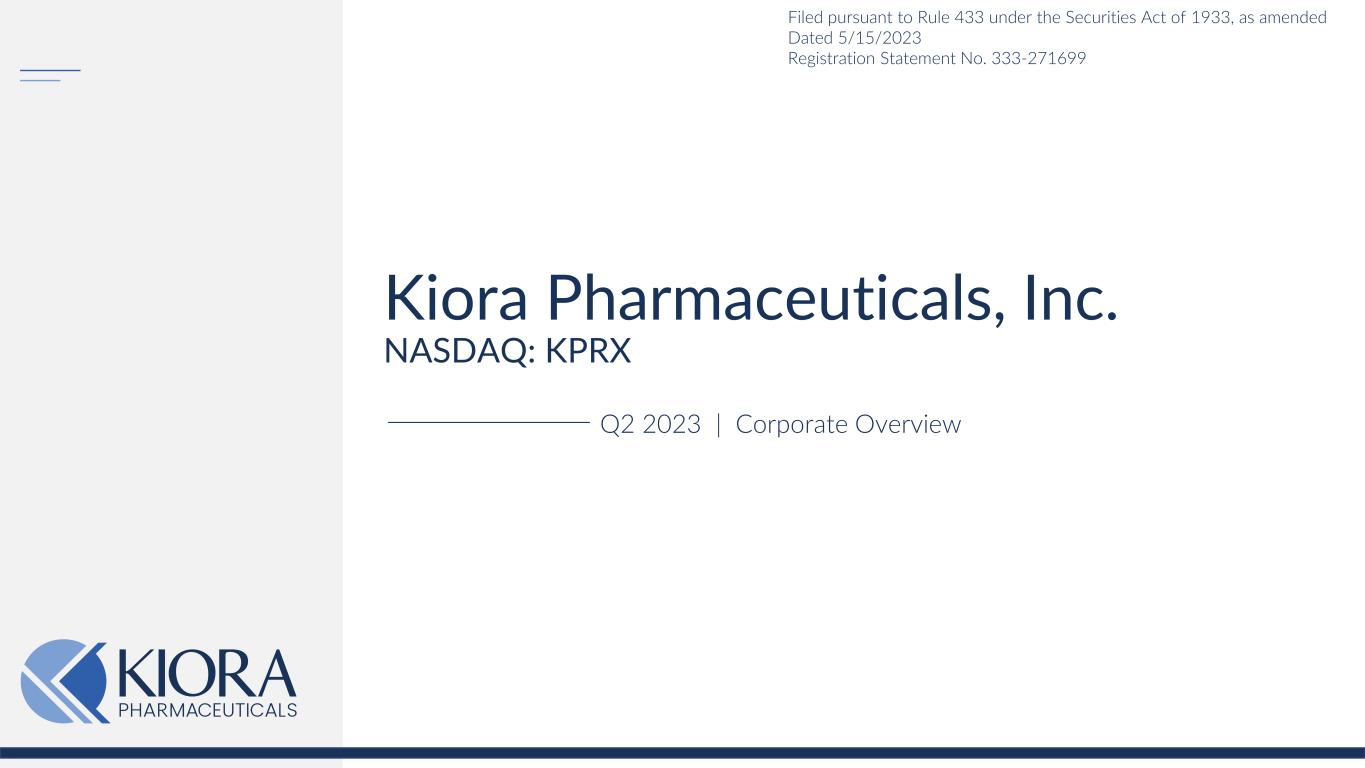
Kiora Pharmaceuticals, Inc. NASDAQ: KPRX Q2 2023 | Corporate Overview Filed pursuant to Rule 433 under the Securities Act of 1933, as amended Dated 5/15/2023 Registration Statement No. 333-271699
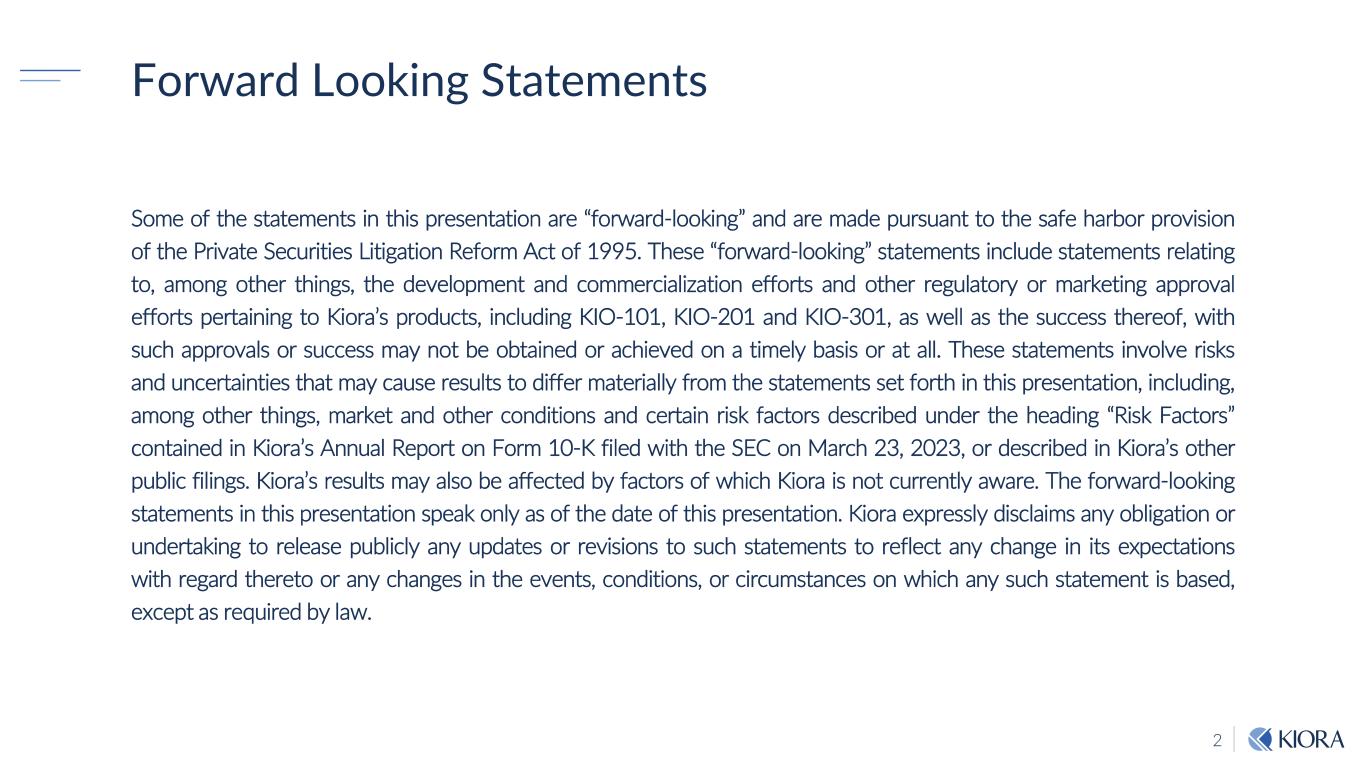
2 Forward Looking Statements Some of the statements in this presentation are “forward-looking” and are made pursuant to the safe harbor provision of the Private Securities Litigation Reform Act of 1995. These “forward-looking” statements include statements relating to, among other things, the development and commercialization efforts and other regulatory or marketing approval efforts pertaining to Kiora’s products, including KIO-101, KIO-201 and KIO-301, as well as the success thereof, with such approvals or success may not be obtained or achieved on a timely basis or at all. These statements involve risks and uncertainties that may cause results to differ materially from the statements set forth in this presentation, including, among other things, market and other conditions and certain risk factors described under the heading “Risk Factors” contained in Kiora’s Annual Report on Form 10-K filed with the SEC on March 23, 2023, or described in Kiora’s other public filings. Kiora’s results may also be affected by factors of which Kiora is not currently aware. The forward-looking statements in this presentation speak only as of the date of this presentation. Kiora expressly disclaims any obligation or undertaking to release publicly any updates or revisions to such statements to reflect any change in its expectations with regard thereto or any changes in the events, conditions, or circumstances on which any such statement is based, except as required by law.

3 Developing Therapeutics for Rare & Underserved Ophthalmic Diseases Priority Asset – KIO-301: Vision Restoration in Retinitis Pigmentosa (RP) ▪ Small molecule “photoswitch” is gene mutation agnostic, easy to deliver ▪ Study fully enrolled, dosing ongoing ▪ Case study presented in Q2 2023, anticipate full results in Q4 2023 KIO-101: Ocular Surface Disease in Rheumatoid Arthritis & Other Autoimmune Diseases (OPRA+) ▪ Small molecule inhibitor of a validated, disease modifying target ▪ First patient, first visit in Q2 2023 ▪ Anticipate full results in Q3 2024 KIO-201: A Novel, Modified Hyaluronic Acid (HA) Molecule for Ocular Wound Healing ▪ Successful Phase 2 Persistent Corneal Epithelial Defects (PCED) trial ▪ Results reported in Q2 2023 ▪ Initiate discussions with FDA for registration trial in 2H 2023 Efficient operating structure with low monthly burn (~$850K) Corporate Highlights
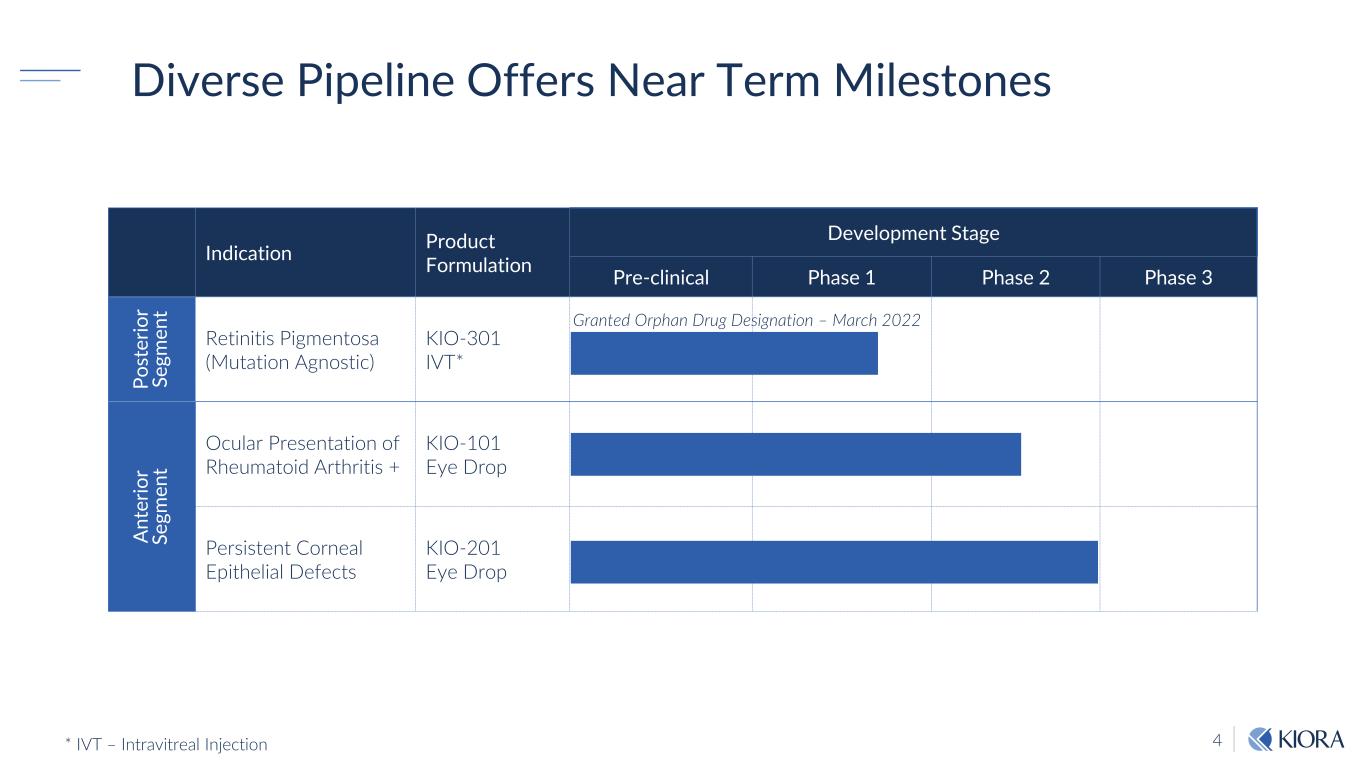
4 Indication Product Formulation Development Stage Pre-clinical Phase 1 Phase 2 Phase 3 P os te ri or Se gm en t Retinitis Pigmentosa (Mutation Agnostic) KIO-301 IVT* A nt er io r Se gm en t Ocular Presentation of Rheumatoid Arthritis + KIO-101 Eye Drop Persistent Corneal Epithelial Defects KIO-201 Eye Drop Diverse Pipeline Offers Near Term Milestones Granted Orphan Drug Designation – March 2022 * IVT – Intravitreal Injection
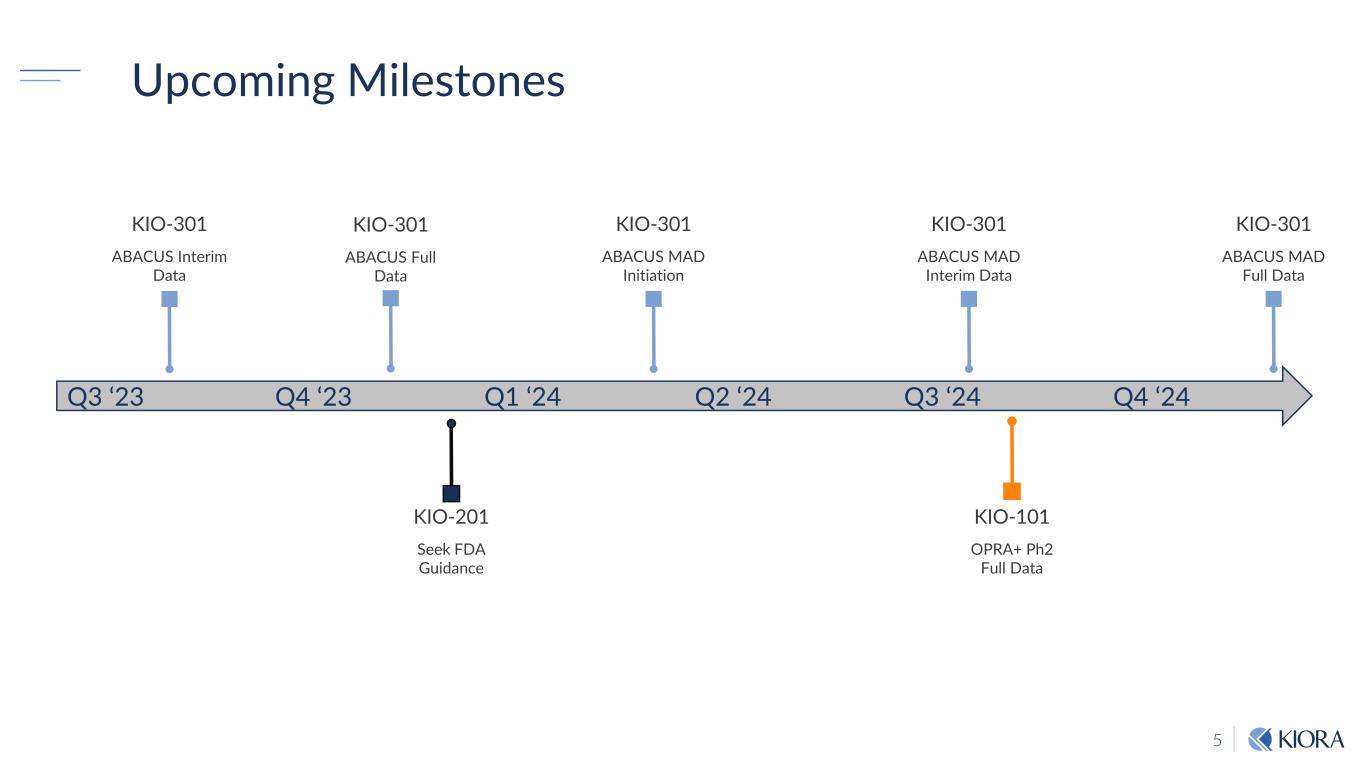
5 Upcoming Milestones Q3 ‘23 Q4 ‘23 Q1 ‘24 Q2 ‘24 Q3 ‘24 Q4 ‘24 KIO-301 ABACUS Interim Data KIO-301 ABACUS Full Data KIO-301 ABACUS MAD Initiation KIO-301 ABACUS MAD Interim Data KIO-301 ABACUS MAD Full Data KIO-101 OPRA+ Ph2 Full Data KIO-201 Seek FDA Guidance
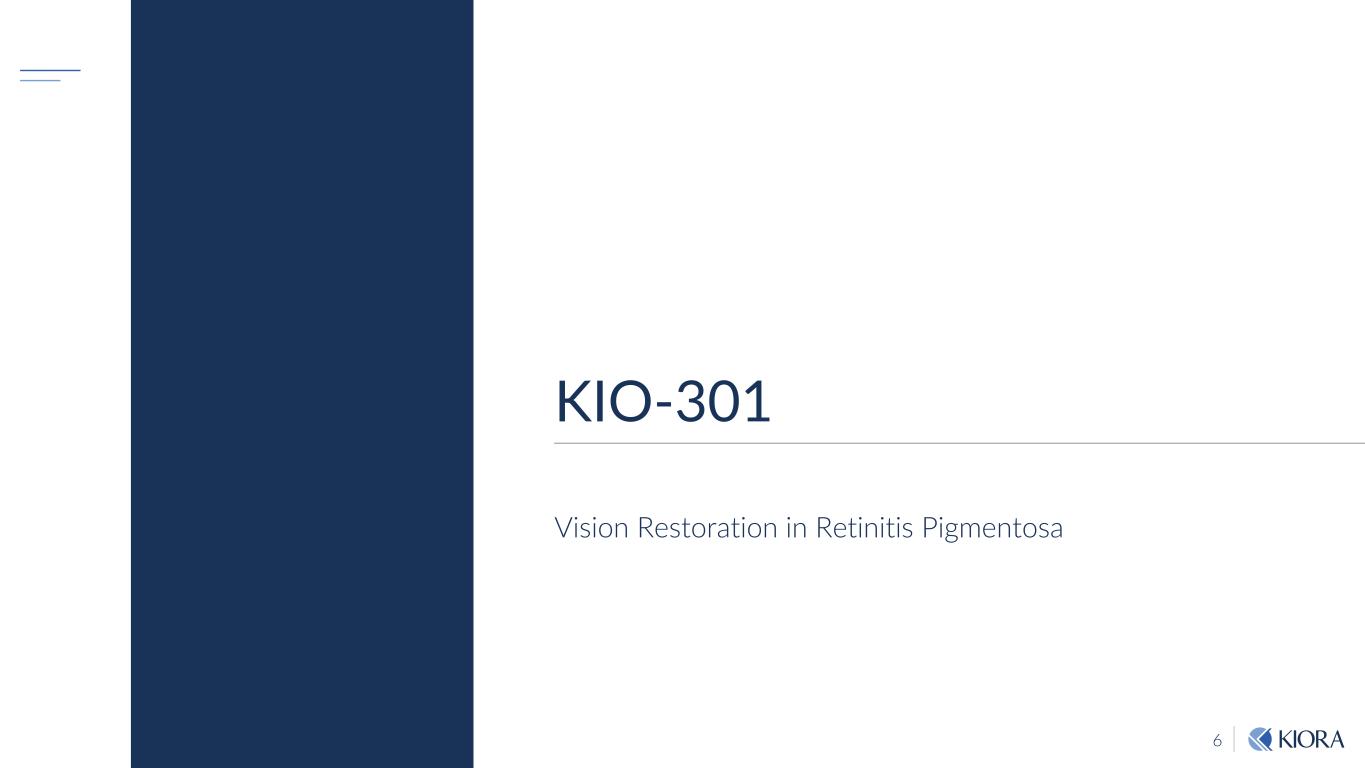
6 KIO-301 Vision Restoration in Retinitis Pigmentosa
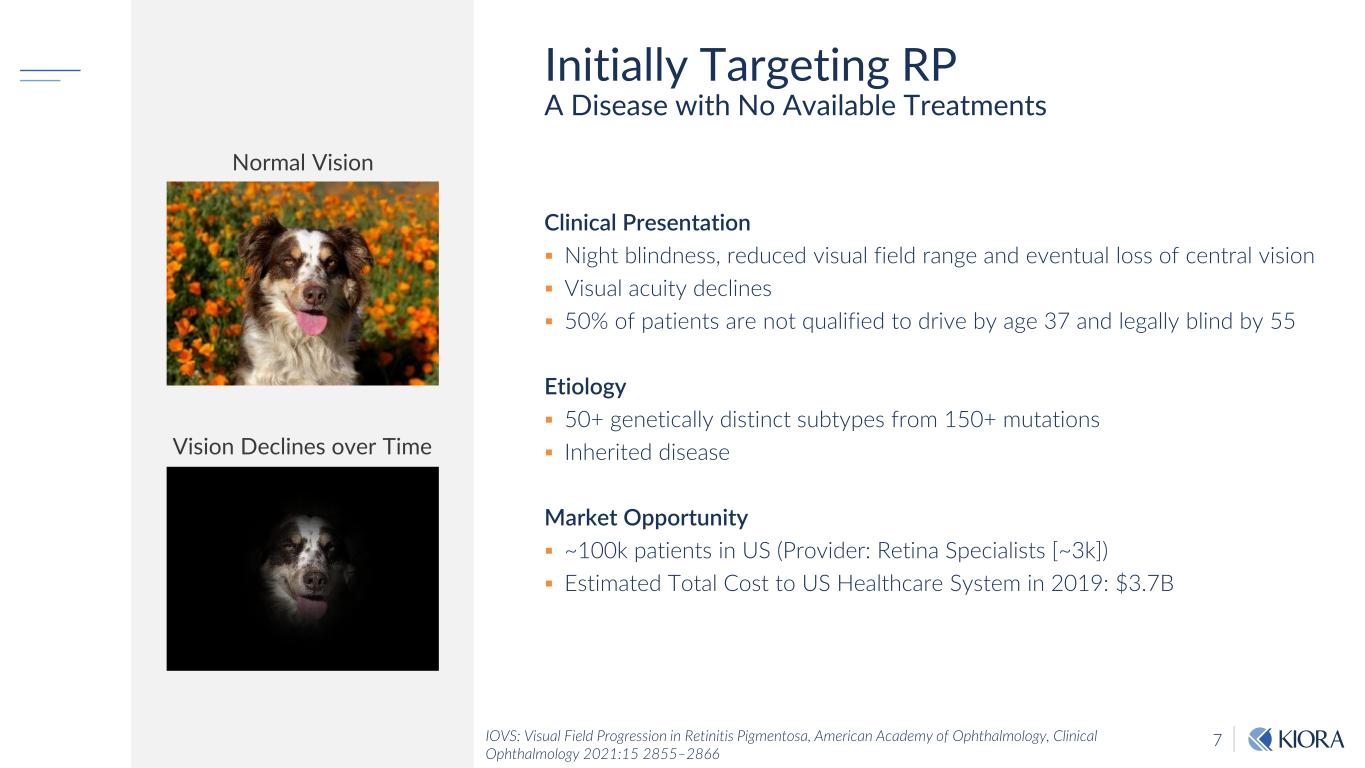
7 Clinical Presentation ▪ Night blindness, reduced visual field range and eventual loss of central vision ▪ Visual acuity declines ▪ 50% of patients are not qualified to drive by age 37 and legally blind by 55 Etiology ▪ 50+ genetically distinct subtypes from 150+ mutations ▪ Inherited disease Market Opportunity ▪ ~100k patients in US (Provider: Retina Specialists [~3k]) ▪ Estimated Total Cost to US Healthcare System in 2019: $3.7B Initially Targeting RP A Disease with No Available Treatments Normal Vision Vision Declines over Time IOVS: Visual Field Progression in Retinitis Pigmentosa, American Academy of Ophthalmology, Clinical Ophthalmology 2021:15 2855–2866
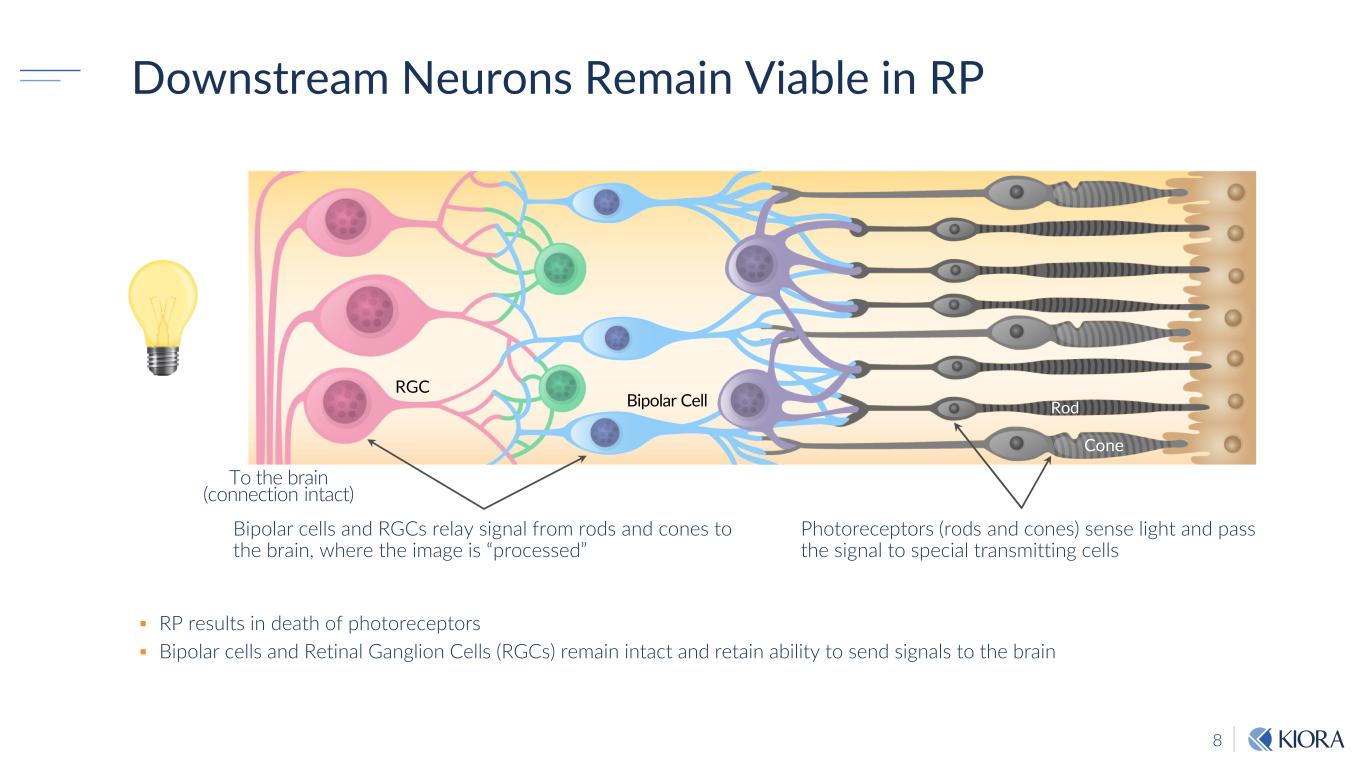
8 Downstream Neurons Remain Viable in RP ▪ RP results in death of photoreceptors ▪ Bipolar cells and Retinal Ganglion Cells (RGCs) remain intact and retain ability to send signals to the brain Photoreceptors (rods and cones) sense light and pass the signal to special transmitting cells Bipolar cells and RGCs relay signal from rods and cones to the brain, where the image is “processed” RGC Bipolar Cell To the brain (connection intact) Cone Rod
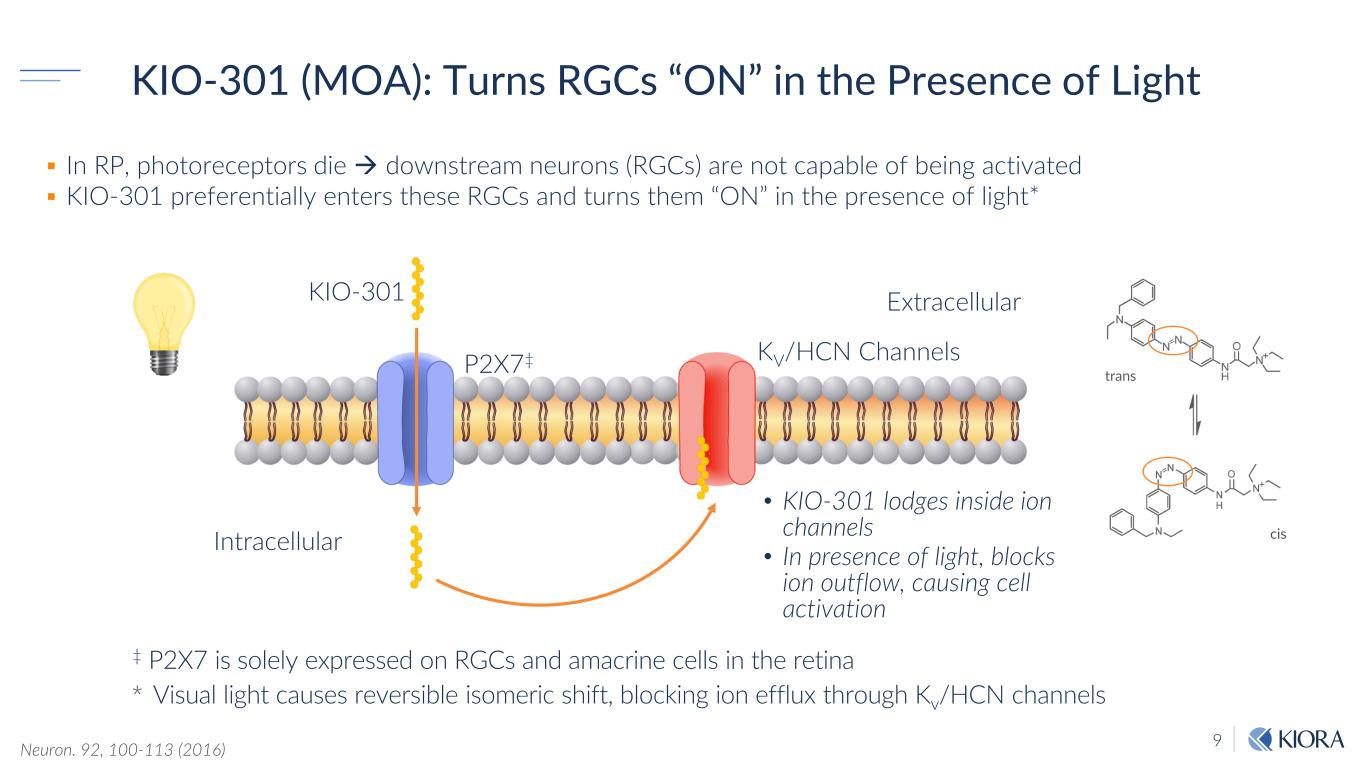
9Neuron. 92, 100-113 (2016) trans cis ▪ In RP, photoreceptors die → downstream neurons (RGCs) are not capable of being activated ▪ KIO-301 preferentially enters these RGCs and turns them “ON” in the presence of light* ‡ P2X7 is solely expressed on RGCs and amacrine cells in the retina * Visual light causes reversible isomeric shift, blocking ion efflux through Kv/HCN channels Intracellular KIO-301 P2X7‡ Extracellular KV/HCN Channels • KIO-301 lodges inside ion channels KIO-301 (MOA): Turns RGCs “ON” in the Presence of Light • In presence of light, blocks ion outflow, causing cell activation
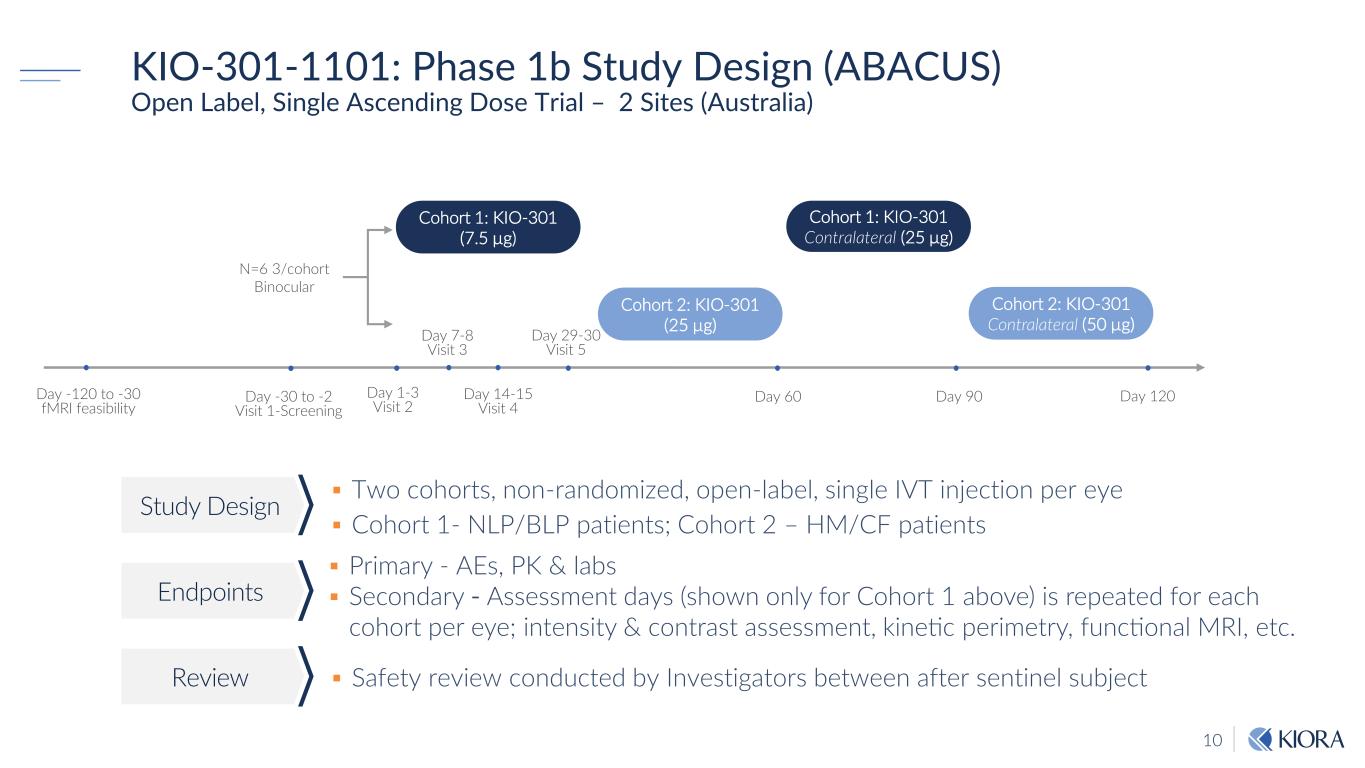
10 KIO-301-1101: Phase 1b Study Design (ABACUS) Open Label, Single Ascending Dose Trial – 2 Sites (Australia) N=6 3/cohort Binocular Day 90 Cohort 1: KIO-301 (7.5 µg) Day -30 to -2 Visit 1-Screening Day 29-30 Visit 5 Day 60 ▪ Two cohorts, non-randomized, open-label, single IVT injection per eye ▪ Cohort 1- NLP/BLP patients; Cohort 2 – HM/CF patients ▪ Primary - AEs, PK & labs ▪ Secondary - Assessment days (shown only for Cohort 1 above) is repeated for each cohort per eye; intensity & contrast assessment, kinetic perimetry, functional MRI, etc. ▪ Safety review conducted by Investigators between after sentinel subject Study Design Endpoints Review Day 120 Cohort 1: KIO-301 Contralateral (25 µg) Cohort 2: KIO-301 (25 µg) Cohort 2: KIO-301 Contralateral (50 µg) Day 1-3 Visit 2 Day 7-8 Visit 3 Day 14-15 Visit 4 Day -120 to -30 fMRI feasibility
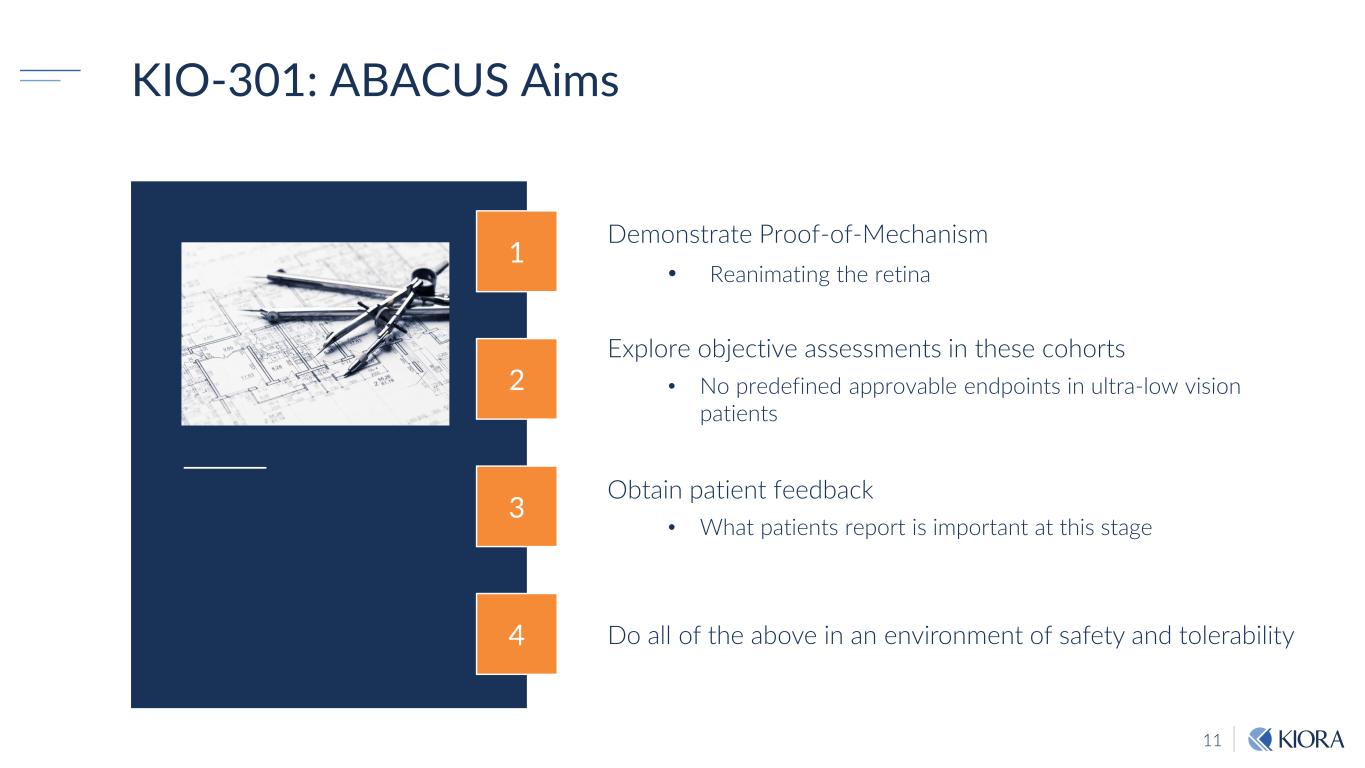
11 KIO-301: ABACUS Aims Explore objective assessments in these cohorts • No predefined approvable endpoints in ultra-low vision patients Do all of the above in an environment of safety and tolerability Obtain patient feedback • What patients report is important at this stage Demonstrate Proof-of-Mechanism • Reanimating the retina 4 3 2 1
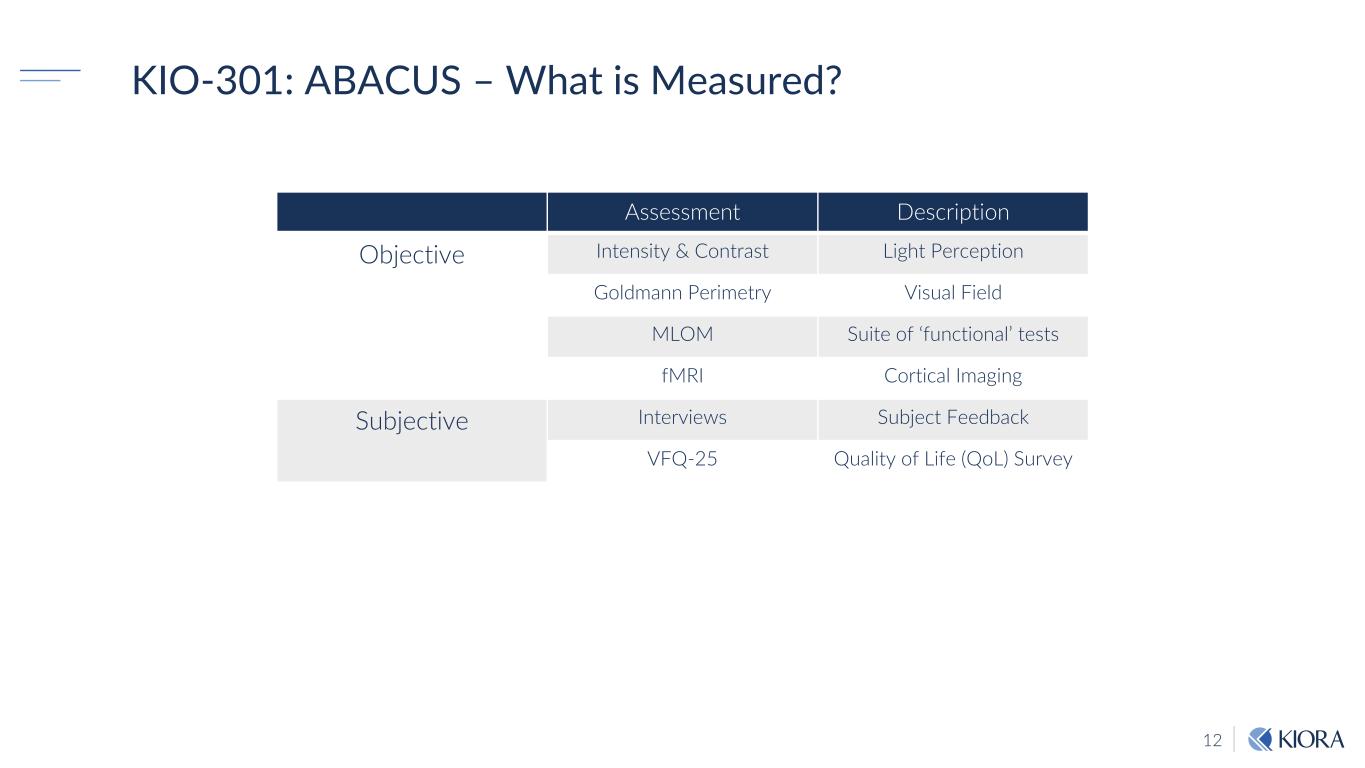
12 KIO-301: ABACUS – What is Measured? Assessment Description Objective Intensity & Contrast Light Perception Goldmann Perimetry Visual Field MLOM Suite of ‘functional’ tests fMRI Cortical Imaging Subjective Interviews Subject Feedback VFQ-25 Quality of Life (QoL) Survey
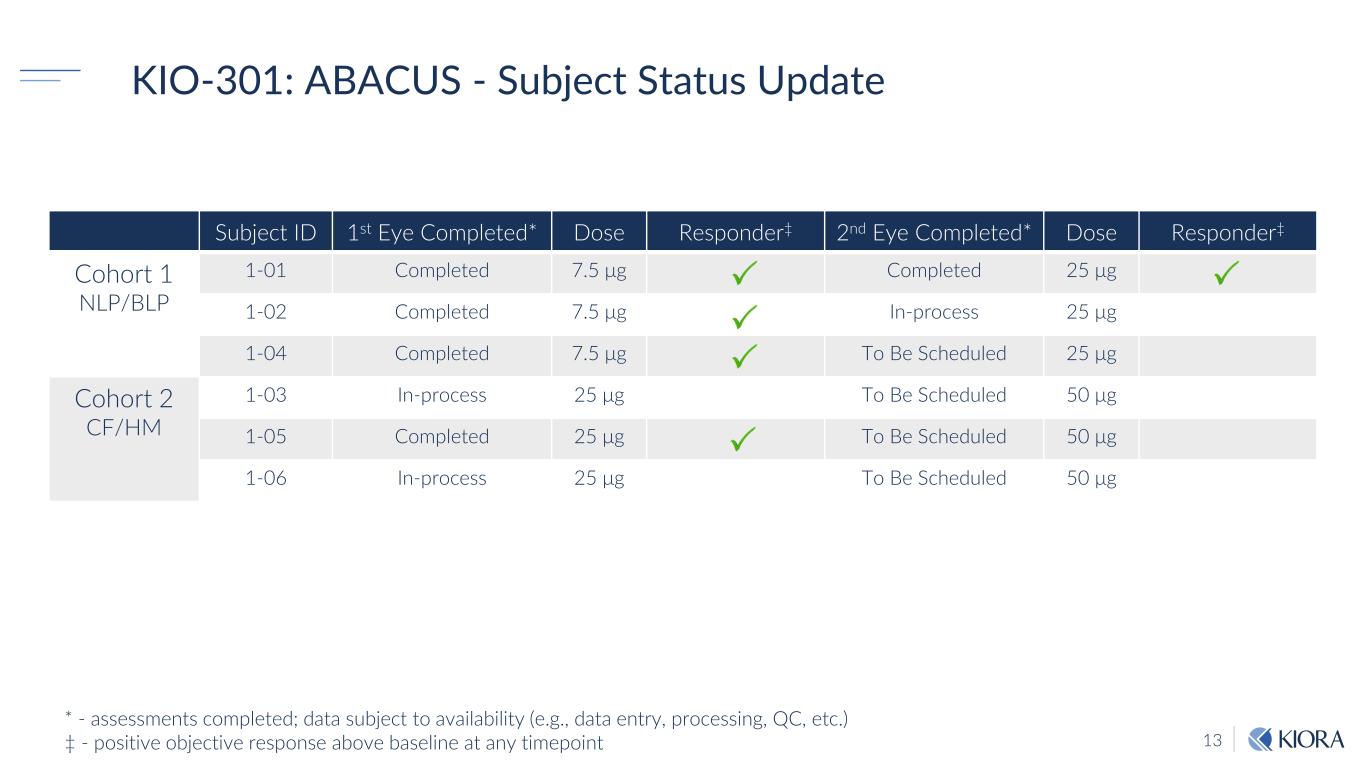
13 KIO-301: ABACUS - Subject Status Update Subject ID 1st Eye Completed* Dose Responder‡ 2nd Eye Completed* Dose Responder‡ Cohort 1 NLP/BLP 1-01 Completed 7.5 μg Completed 25 μg 1-02 Completed 7.5 μg In-process 25 μg 1-04 Completed 7.5 μg To Be Scheduled 25 μg Cohort 2 CF/HM 1-03 In-process 25 μg To Be Scheduled 50 μg 1-05 Completed 25 μg To Be Scheduled 50 μg 1-06 In-process 25 μg To Be Scheduled 50 μg * - assessments completed; data subject to availability (e.g., data entry, processing, QC, etc.) ‡ - positive objective response above baseline at any timepoint

14 KIO-301: ABACUS Completed Subjects – Responder Matrix* Subject ID Intensity & Contrast Visual Field MLOM fMRI VFQ-25 (QoL) Subject Feedback Dose Response 1-01 1-02 N/A In-process 1-04 N/A In-process In-process 1-05 N/A In-process In-process In-process *+ve objective response above baseline at any timepoint; N/A – testing not appropriate for level of vision or baseline ≥ 90%

15 KIO-301: ABACUS Safety & Tolerability IOP – all patients normal and no change to baseline, except 1 patient had bilateral increase in IOP (21→27 mmHg). Rapidly responded to pharmacological intervention (timolol). OCT - no macula edema, no change in thickness. Dilated Fundus w/ photography* - abnormal at baseline (consistent with RP); no change to baseline. Slit-lamp – abnormal baseline corneal keratopathy; no changes observed compared to baseline. ✓ ✓ ✓ ✓Systemic & Ocular Safety Assessments ‡ Mild; IOP increase coded as possibly related; eye soreness after injection coded as unrelated * Performed within 6 hours of injection & Day 29 Safe & Well Tolerated‡
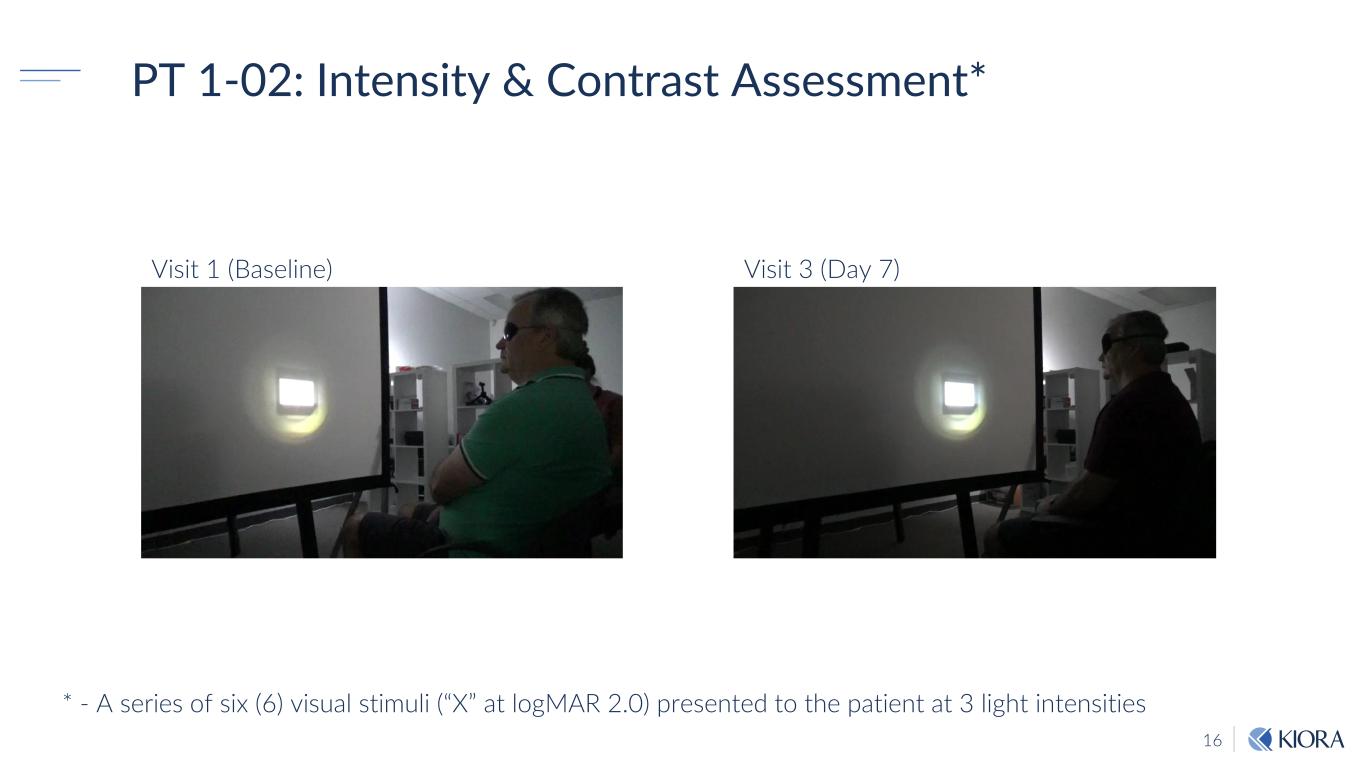
16 PT 1-02: Intensity & Contrast Assessment* Visit 1 (Baseline) Visit 3 (Day 7) * - A series of six (6) visual stimuli (“X” at logMAR 2.0) presented to the patient at 3 light intensities

17 Key Takeaways: • Light perception increases over first 2 weeks following injection • Return to baseline expected Pt 1-02: Intensity & Contrast Assessment V is it 1 (B as el in e) V is it 2 (D ay 2 ) V is it 3 (D ay 7 ) V is it 4 (D ay 1 4) V is it 5 (D ay 2 9) V is it 1 (B as el in e) V is it 2 (D ay 2 ) V is it 3 (D ay 7 ) V is it 4 (D ay 1 4) V is it 5 (D ay 2 9) V is it 1 (B as el in e) V is it 2 (D ay 2 ) V is it 3 (D ay 7 ) V is it 4 (D ay 1 4) V is it 5 (D ay 2 9) 0 20 40 60 1-02-Intensity/Contrast-OD % C o rr e c t 400 Lux 1,700 Lux 6,100 Lux
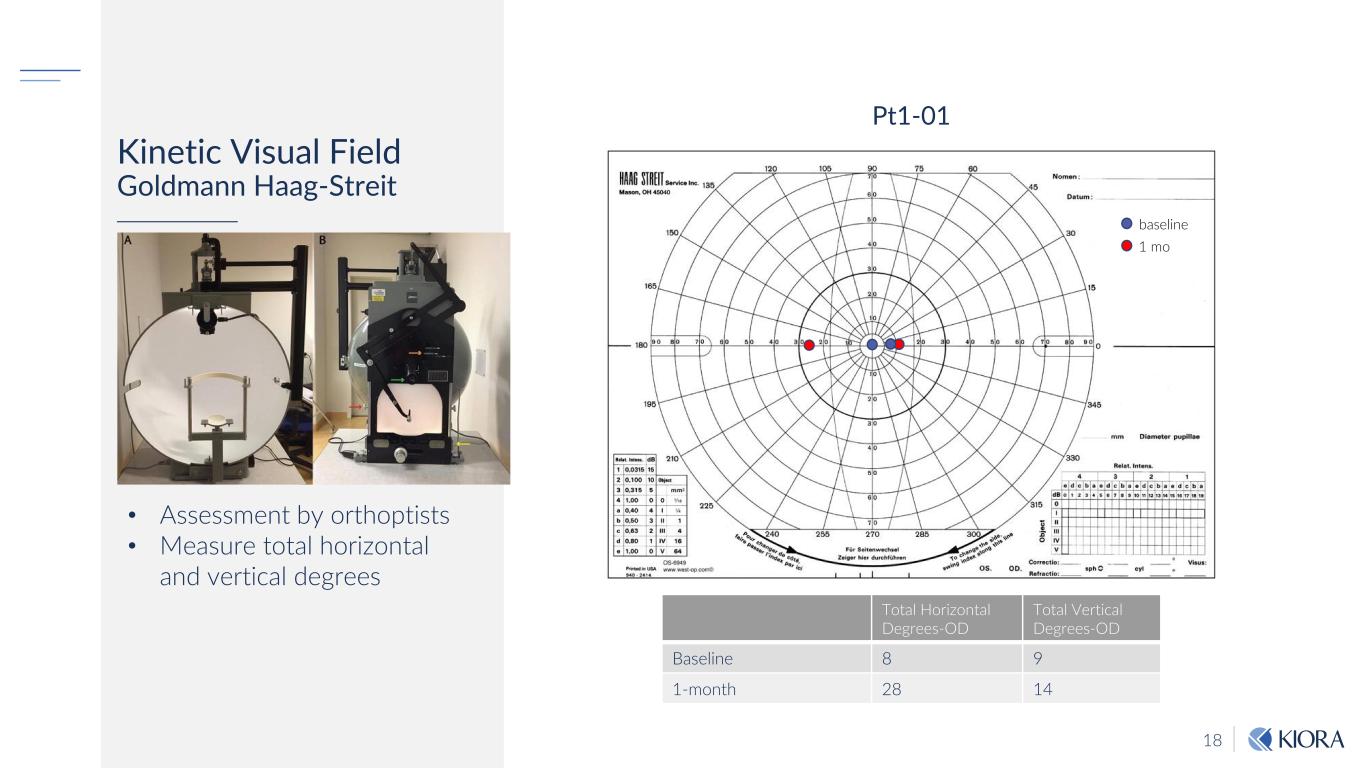
18 Kinetic Visual Field Goldmann Haag-Streit Total Horizontal Degrees-OD Total Vertical Degrees-OD Baseline 8 9 1-month 28 14 • Assessment by orthoptists • Measure total horizontal and vertical degrees baseline 1 mo Pt1-01
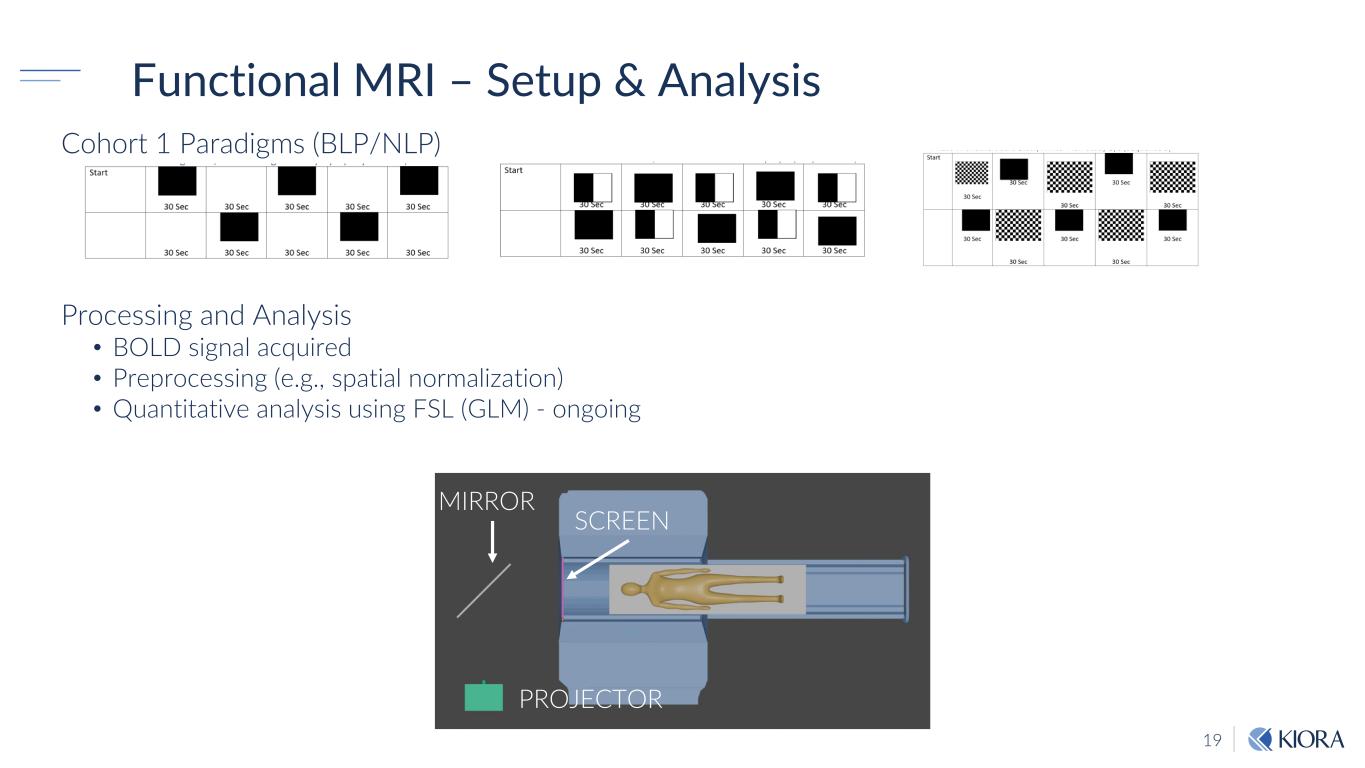
19 Cohort 1 Paradigms (BLP/NLP) Processing and Analysis • BOLD signal acquired • Preprocessing (e.g., spatial normalization) • Quantitative analysis using FSL (GLM) - ongoing PROJECTOR MIRROR SCREEN Functional MRI – Setup & Analysis
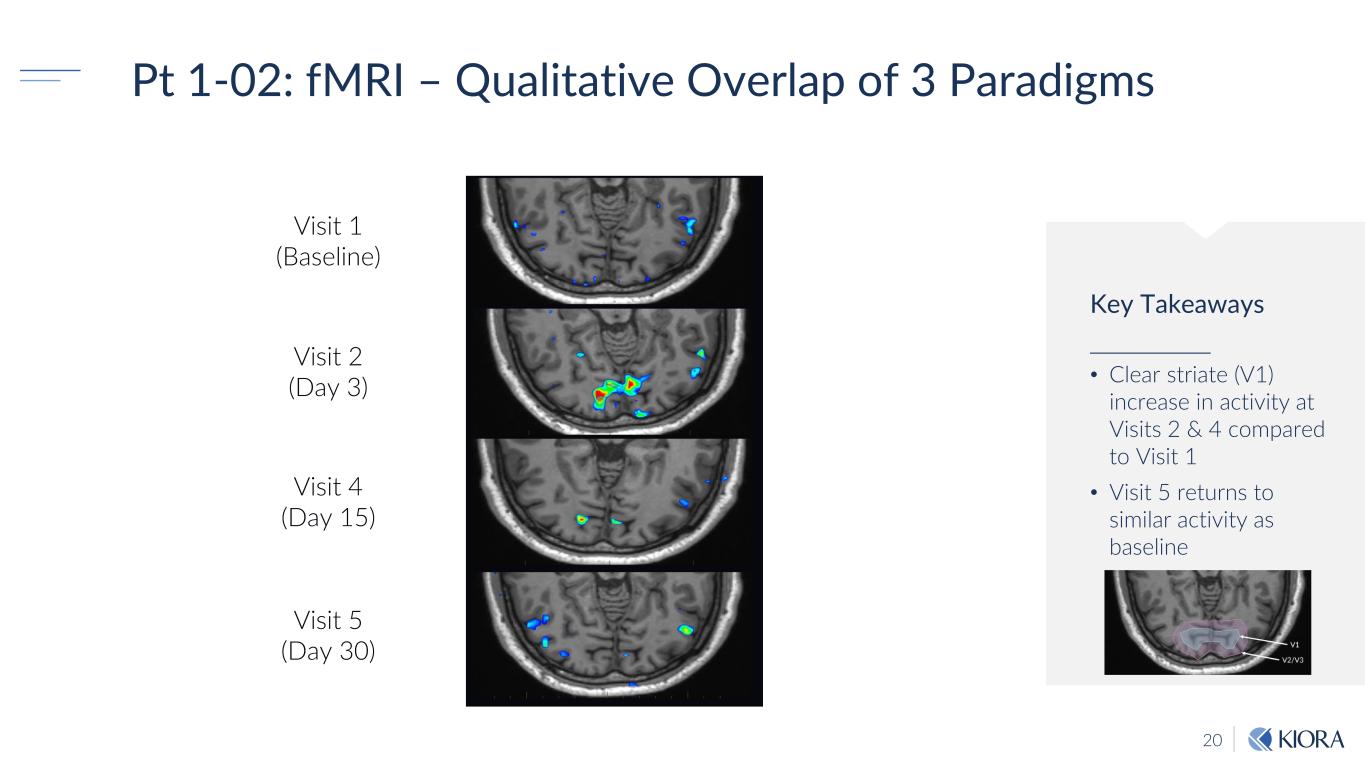
20 Key Takeaways • Clear striate (V1) increase in activity at Visits 2 & 4 compared to Visit 1 • Visit 5 returns to similar activity as baseline Pt 1-02: fMRI – Qualitative Overlap of 3 Paradigms Visit 1 (Baseline) Visit 2 (Day 3) Visit 4 (Day 15) Visit 5 (Day 30)
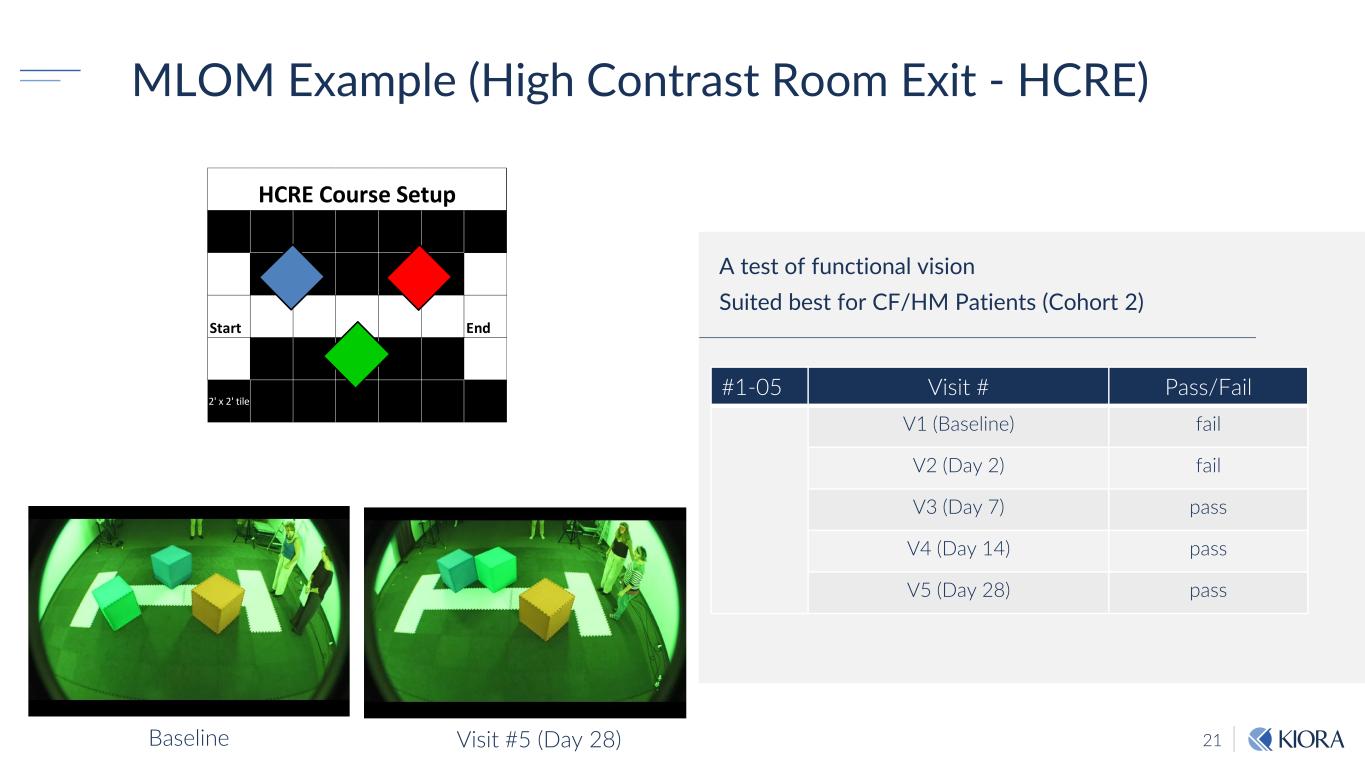
21 MLOM Example (High Contrast Room Exit - HCRE) A test of functional vision Suited best for CF/HM Patients (Cohort 2) Start End 2' x 2' tile HCRE Course Setup #1-05 Visit # Pass/Fail V1 (Baseline) fail V2 (Day 2) fail V3 (Day 7) pass V4 (Day 14) pass V5 (Day 28) pass Baseline Visit #5 (Day 28)
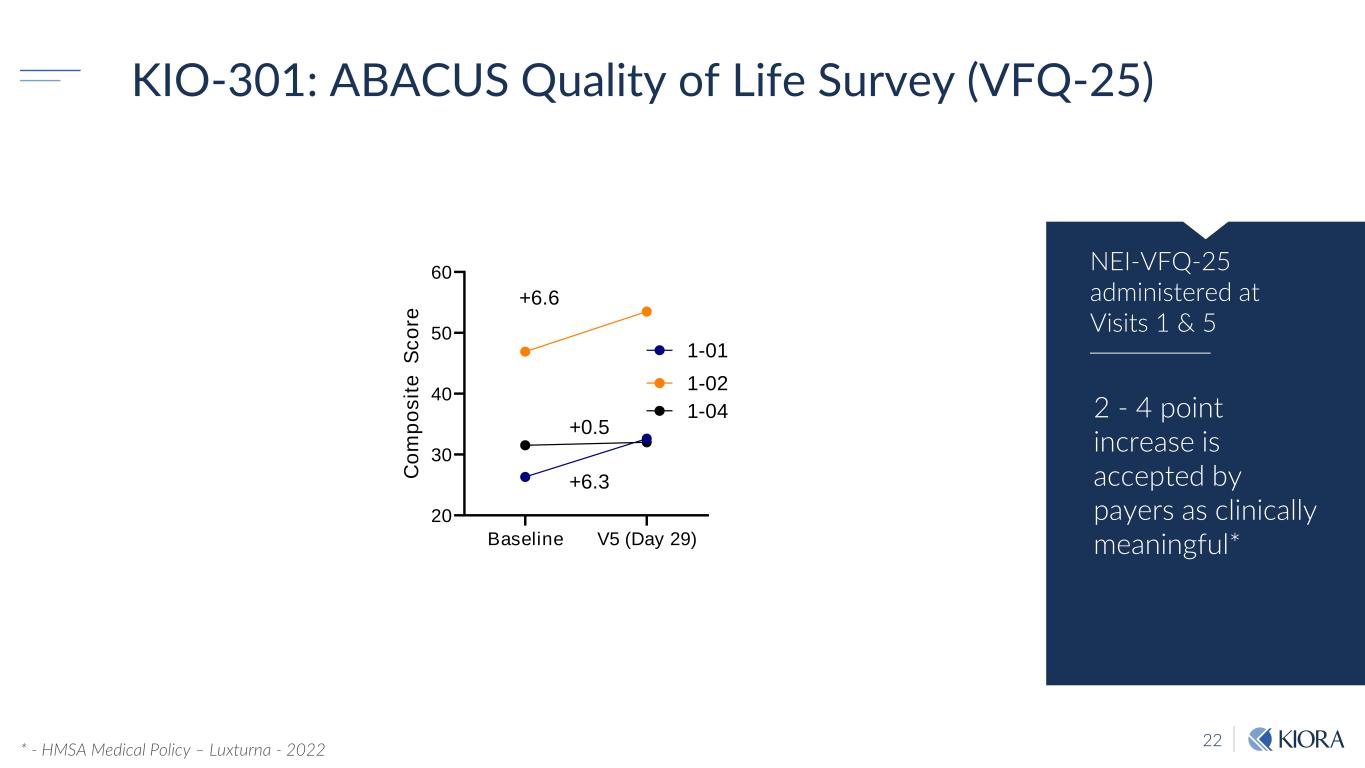
22 NEI-VFQ-25 administered at Visits 1 & 5 KIO-301: ABACUS Quality of Life Survey (VFQ-25) 2 - 4 point increase is accepted by payers as clinically meaningful* * - HMSA Medical Policy – Luxturna - 2022 Baseline V5 (Day 29) 20 30 40 50 60 C o m p o s it e S c o re 1-01 1-02 +6.3 +6.6 1-04 +0.5
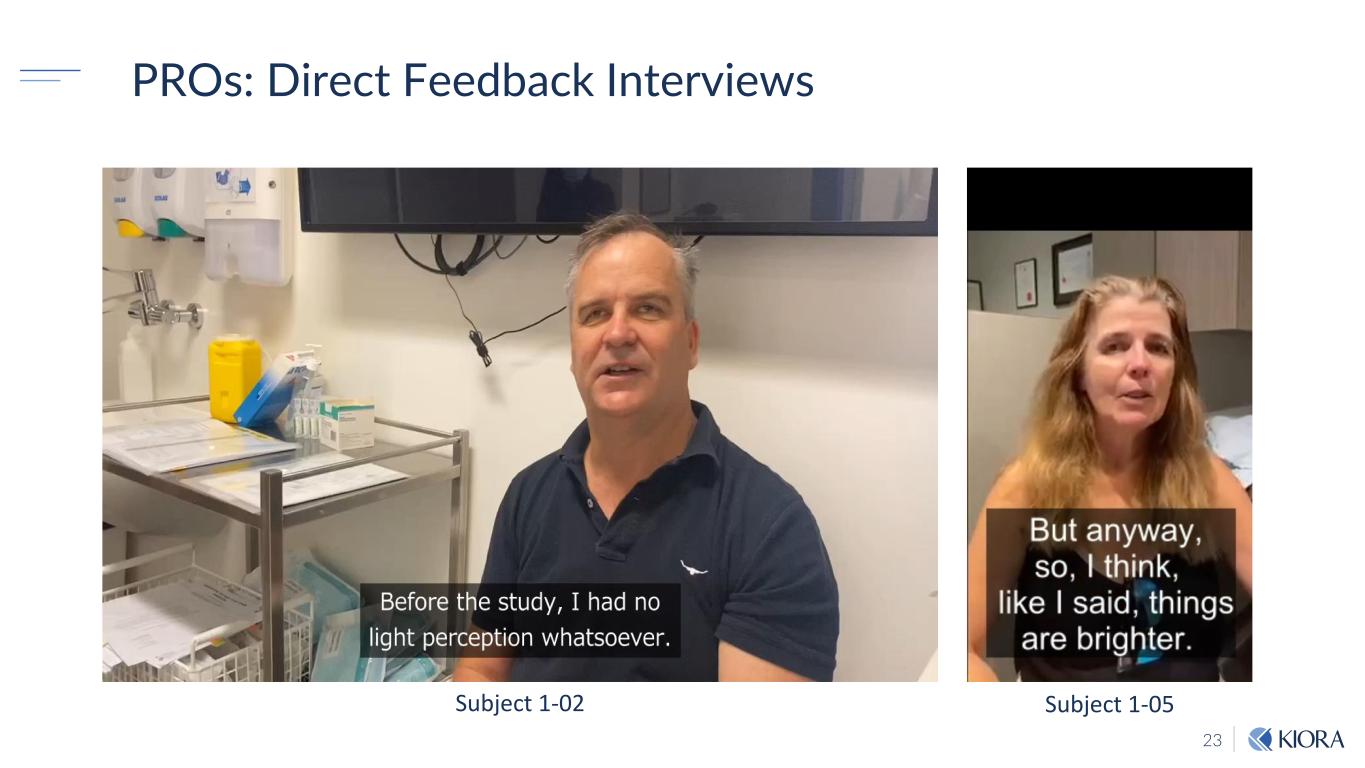
23 PROs: Direct Feedback Interviews Subject 1-02 Subject 1-05
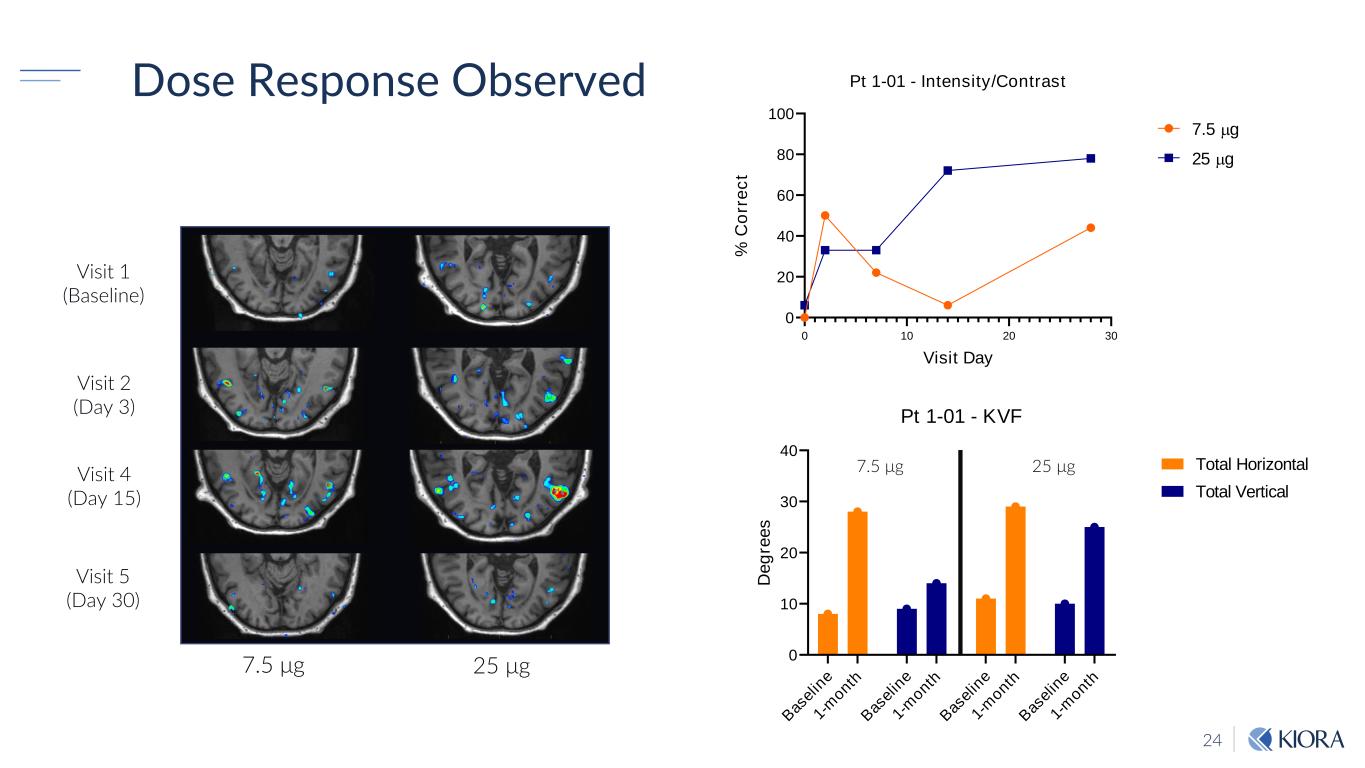
24 Dose Response Observed 0 10 20 30 0 20 40 60 80 100 Pt 1-01 - Intensity/Contrast Visit Day % C o rr e c t 7.5 g 25 g B as el in e 1- m onth B as el in e 1- m onth B as el in e 1- m onth B as el in e 1- m onth 0 10 20 30 40 Pt 1-01 - KVF D e g re e s Total Horizontal Total Vertical 7.5 μg 25 μg 7.5 μg 25 μg Visit 1 (Baseline) Visit 2 (Day 3) Visit 4 (Day 15) Visit 5 (Day 30)

25 KIO-301: ABACUS Key Takeaways ✓ Intravitreal KIO-301 is safe and tolerable, to date ✓ All patients treated demonstrate objective and subjective responses ✓ Dose response ✓ Appears to have more robust response & longer duration of effect ✓ Enrollment complete, dosing ongoing with full data expected in Q4 2023
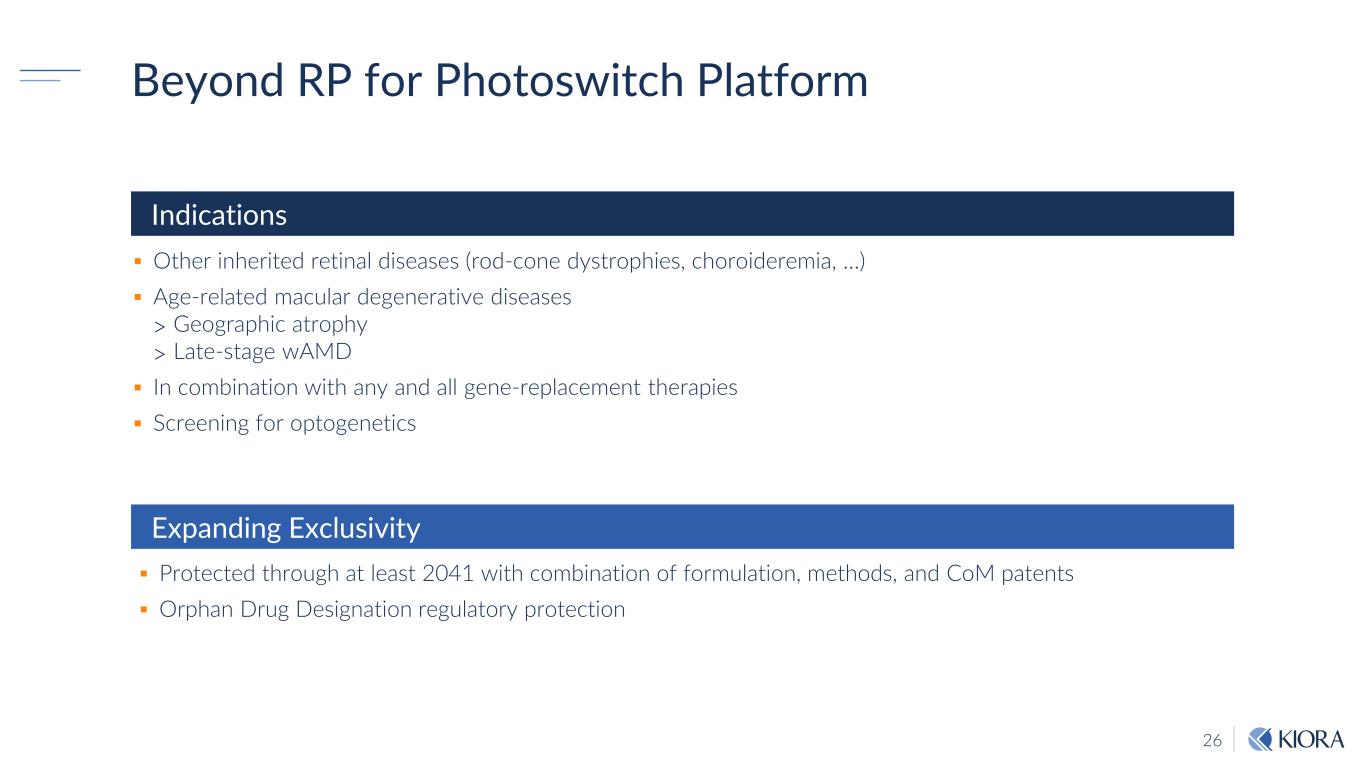
26 Beyond RP for Photoswitch Platform ▪ Other inherited retinal diseases (rod-cone dystrophies, choroideremia, …) ▪ Age-related macular degenerative diseases > Geographic atrophy > Late-stage wAMD ▪ In combination with any and all gene-replacement therapies ▪ Screening for optogenetics Indications Expanding Exclusivity ▪ Protected through at least 2041 with combination of formulation, methods, and CoM patents ▪ Orphan Drug Designation regulatory protection
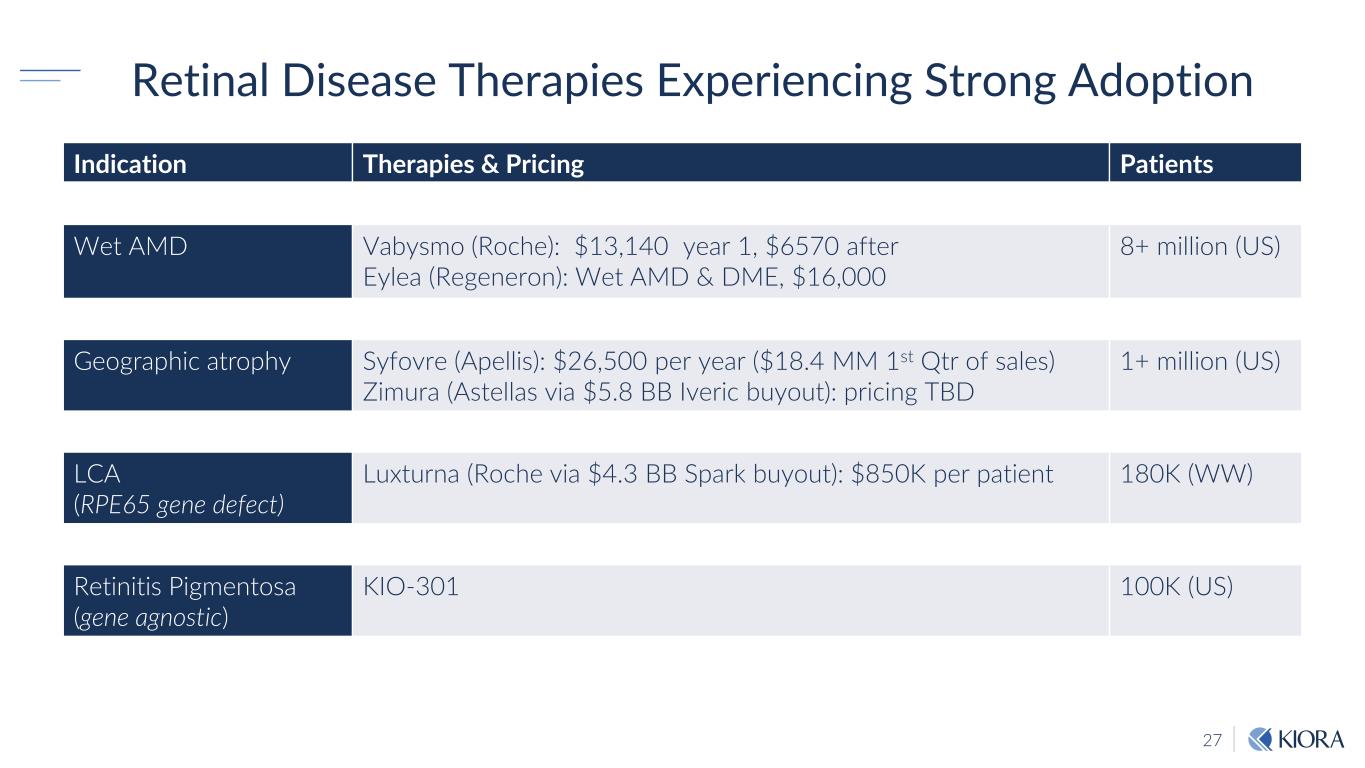
27 Retinal Disease Therapies Experiencing Strong Adoption Indication Therapies & Pricing Patients Wet AMD Vabysmo (Roche): $13,140 year 1, $6570 after Eylea (Regeneron): Wet AMD & DME, $16,000 8+ million (US) Geographic atrophy Syfovre (Apellis): $26,500 per year ($18.4 MM 1st Qtr of sales) Zimura (Astellas via $5.8 BB Iveric buyout): pricing TBD 1+ million (US) LCA (RPE65 gene defect) Luxturna (Roche via $4.3 BB Spark buyout): $850K per patient 180K (WW) Retinitis Pigmentosa (gene agnostic) KIO-301 100K (US)
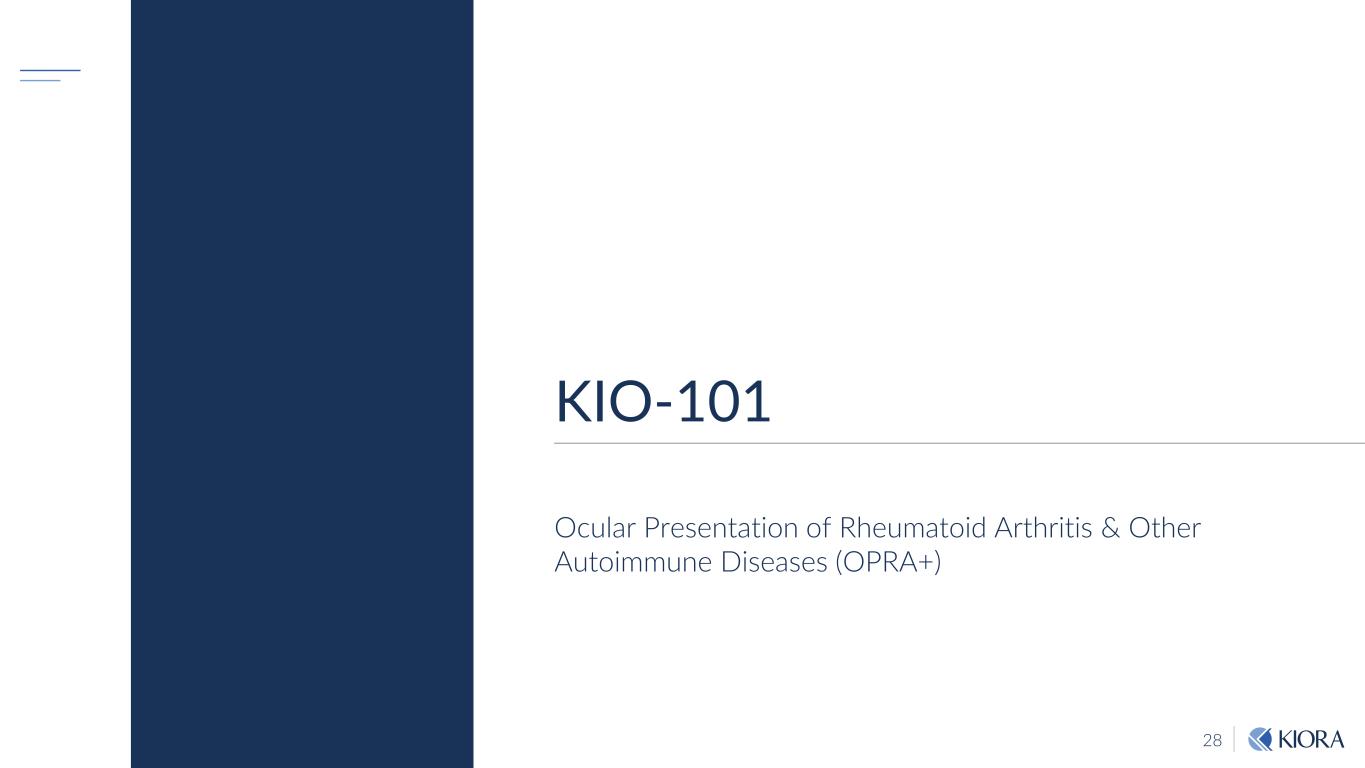
28 KIO-101 Ocular Presentation of Rheumatoid Arthritis & Other Autoimmune Diseases (OPRA+)
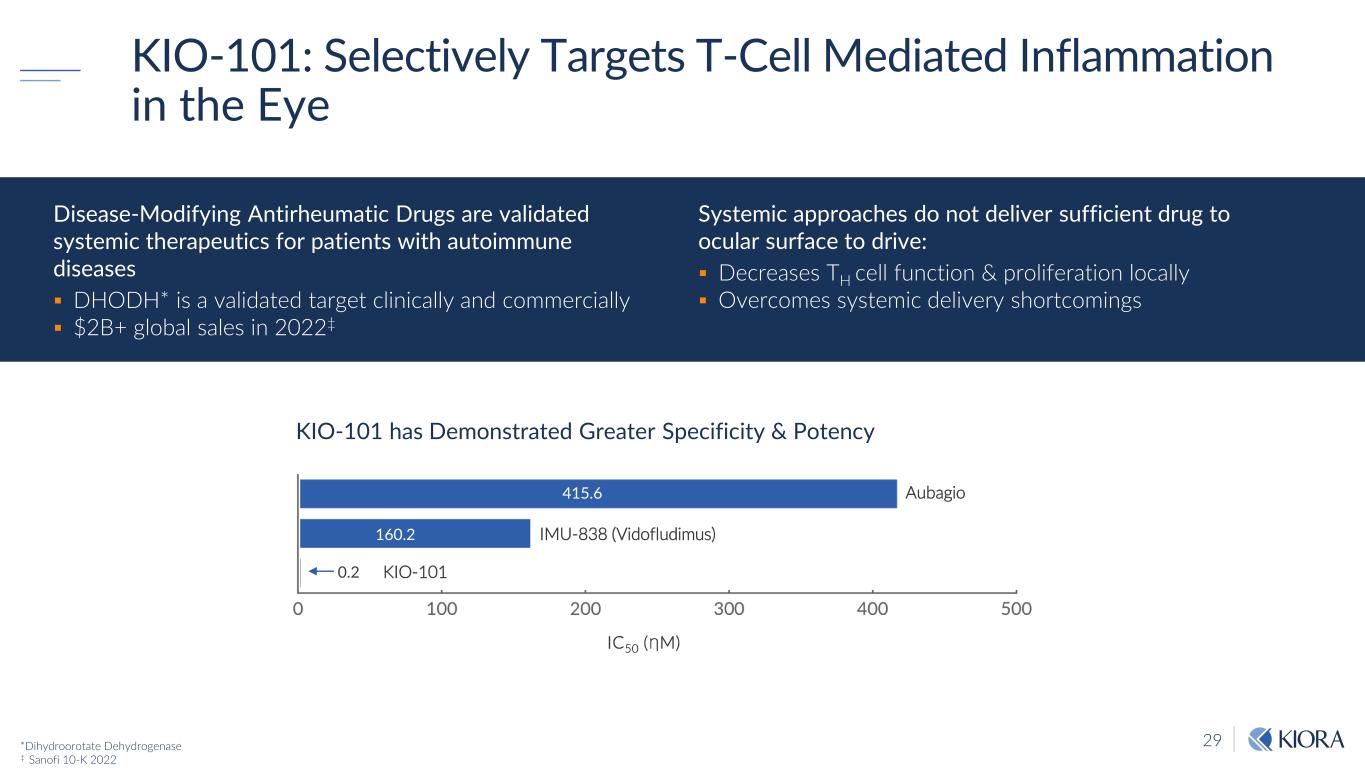
29 KIO-101: Selectively Targets T-Cell Mediated Inflammation in the Eye *Dihydroorotate Dehydrogenase ‡ Sanofi 10-K 2022 KIO-101 has Demonstrated Greater Specificity & Potency IMU-838 (Vidofludimus) Aubagio KIO-101 415.6 160.2 0.2 IC50 (ȠM) Systemic approaches do not deliver sufficient drug to ocular surface to drive: ▪ Decreases TH cell function & proliferation locally ▪ Overcomes systemic delivery shortcomings Disease-Modifying Antirheumatic Drugs are validated systemic therapeutics for patients with autoimmune diseases ▪ DHODH* is a validated target clinically and commercially ▪ $2B+ global sales in 2022‡
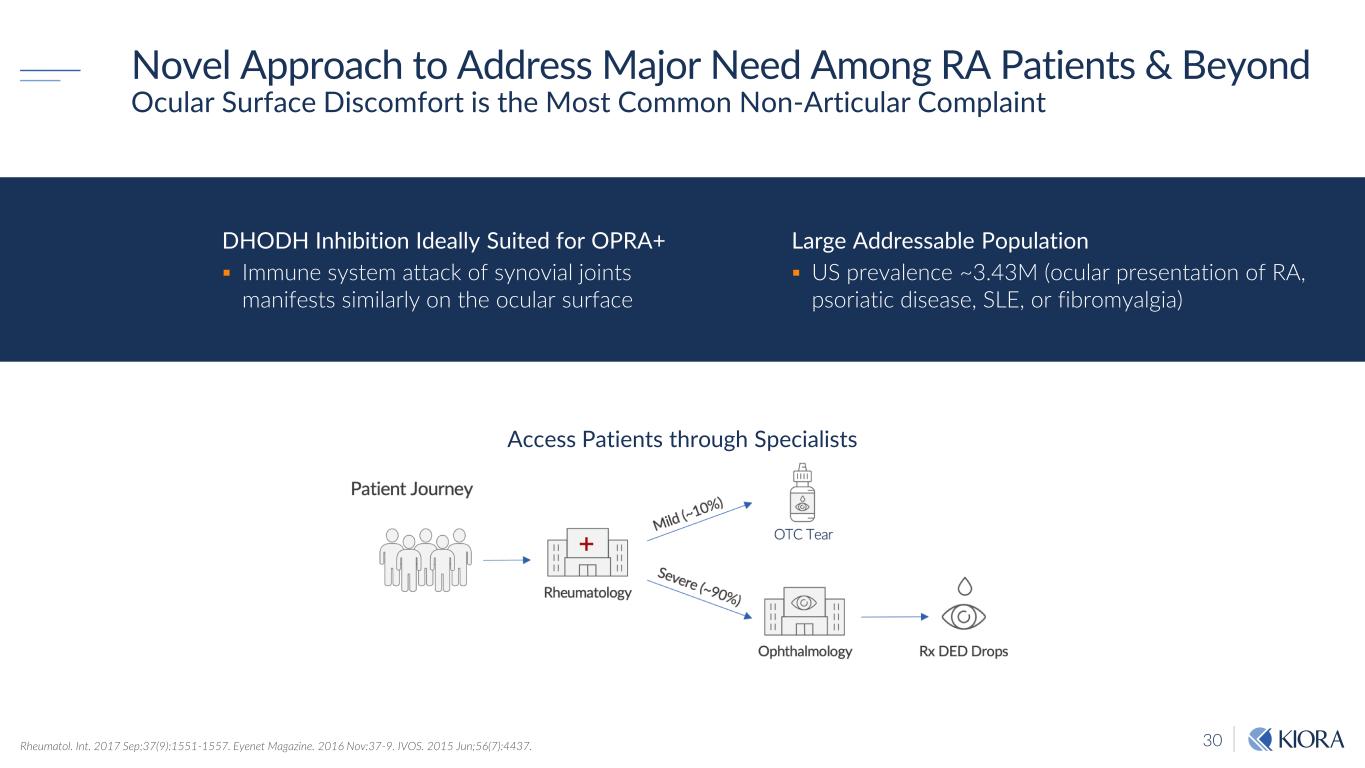
30 Novel Approach to Address Major Need Among RA Patients & Beyond Ocular Surface Discomfort is the Most Common Non-Articular Complaint Rheumatol. Int. 2017 Sep;37(9):1551-1557. Eyenet Magazine. 2016 Nov:37-9. IVOS. 2015 Jun;56(7):4437. Access Patients through Specialists DHODH Inhibition Ideally Suited for OPRA+ ▪ Immune system attack of synovial joints manifests similarly on the ocular surface Large Addressable Population ▪ US prevalence ~3.43M (ocular presentation of RA, psoriatic disease, SLE, or fibromyalgia)
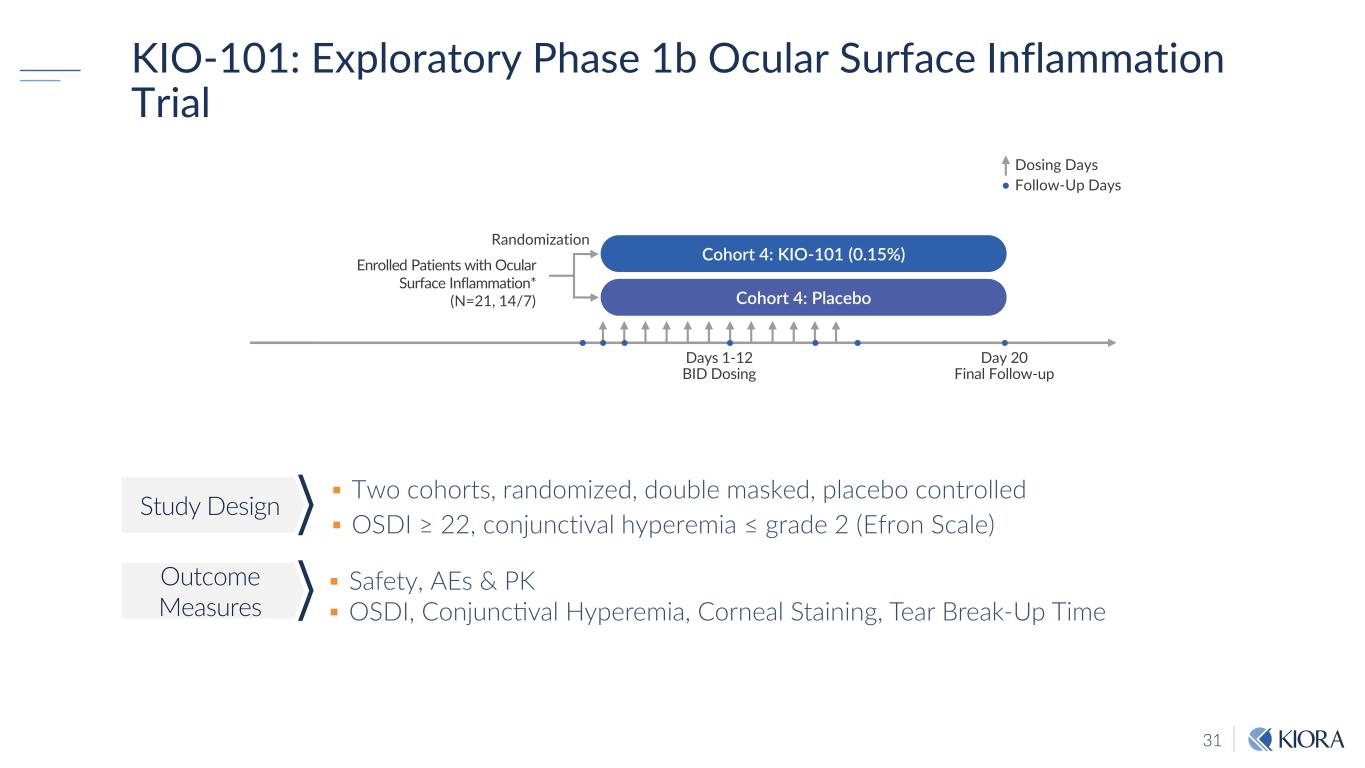
31 KIO-101: Exploratory Phase 1b Ocular Surface Inflammation Trial Enrolled Patients with Ocular Surface Inflammation* (N=21, 14/7) Randomization Days 1-12 BID Dosing Day 20 Final Follow-up Cohort 4: KIO-101 (0.15%) Cohort 4: Placebo Dosing Days Follow-Up Days ▪ Two cohorts, randomized, double masked, placebo controlled ▪ OSDI ≥ 22, conjunctival hyperemia ≤ grade 2 (Efron Scale) ▪ Safety, AEs & PK ▪ OSDI, Conjunctival Hyperemia, Corneal Staining, Tear Break-Up Time Study Design Outcome Measures
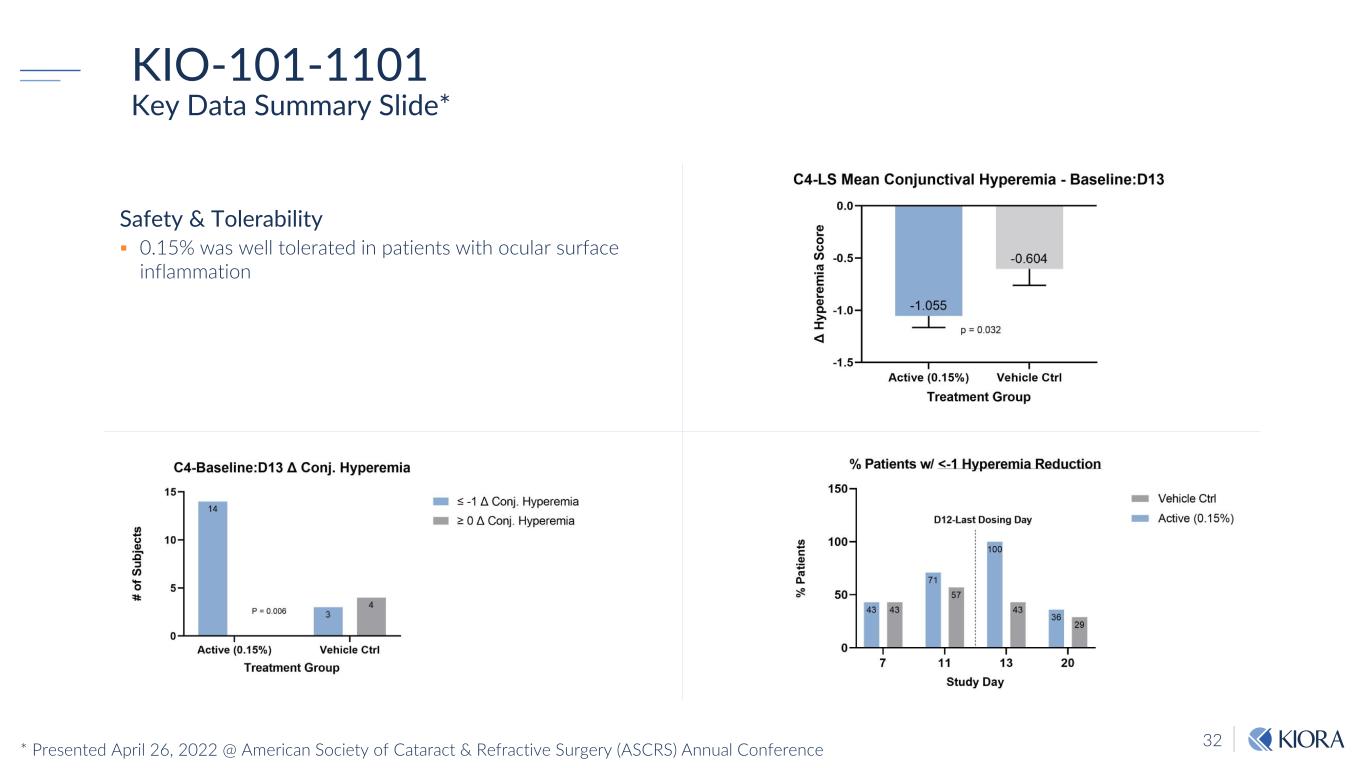
32 KIO-101-1101 Key Data Summary Slide* Safety & Tolerability ▪ 0.15% was well tolerated in patients with ocular surface inflammation * Presented April 26, 2022 @ American Society of Cataract & Refractive Surgery (ASCRS) Annual Conference
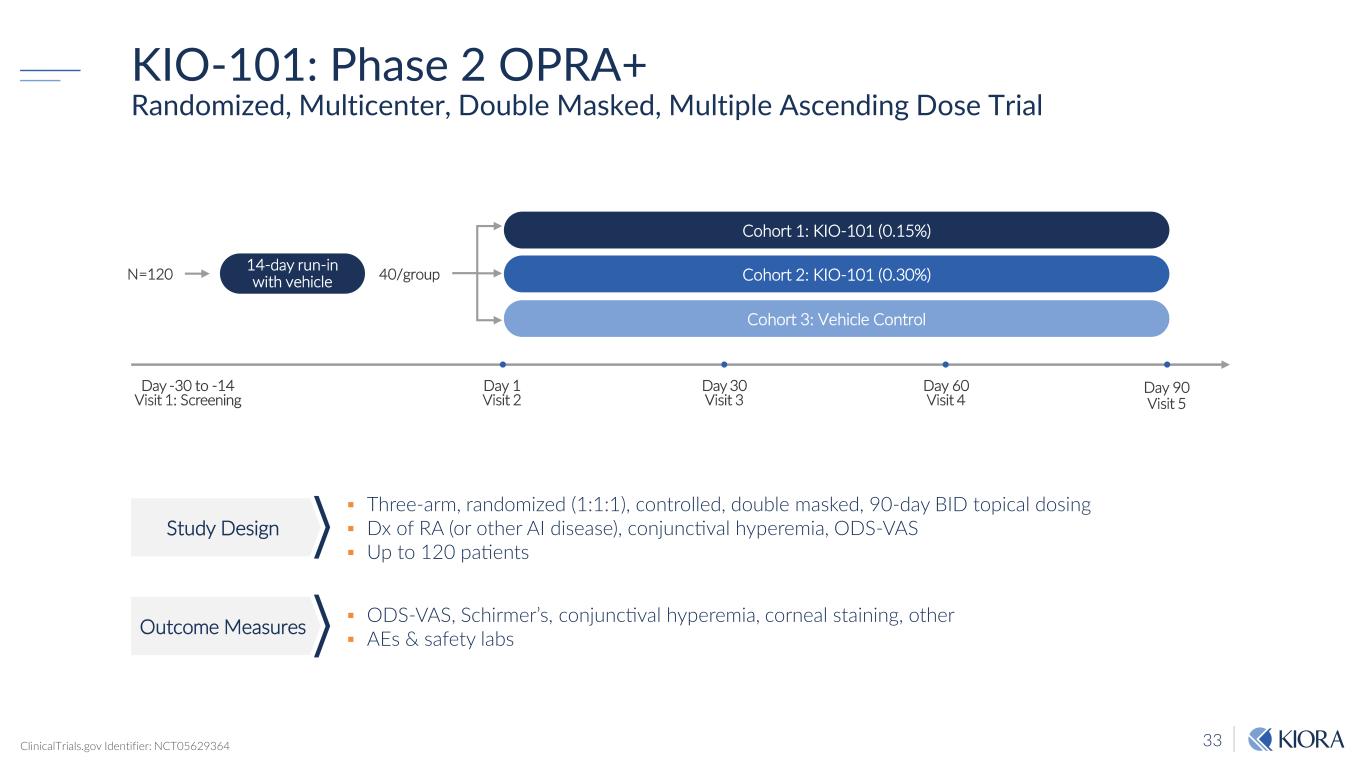
33 KIO-101: Phase 2 OPRA+ Randomized, Multicenter, Double Masked, Multiple Ascending Dose Trial ▪ Three-arm, randomized (1:1:1), controlled, double masked, 90-day BID topical dosing ▪ Dx of RA (or other AI disease), conjunctival hyperemia, ODS-VAS ▪ Up to 120 patients ▪ ODS-VAS, Schirmer’s, conjunctival hyperemia, corneal staining, other ▪ AEs & safety labs N=120 Day 90 Visit 5 Cohort 1: KIO-101 (0.15%) Cohort 2: KIO-101 (0.30%) Day 1 Visit 2 Cohort 3: Vehicle Control Day -30 to -14 Visit 1: Screening Day 30 Visit 3 Day 60 Visit 4 14-day run-in with vehicle 40/group ClinicalTrials.gov Identifier: NCT05629364 Study Design Outcome Measures
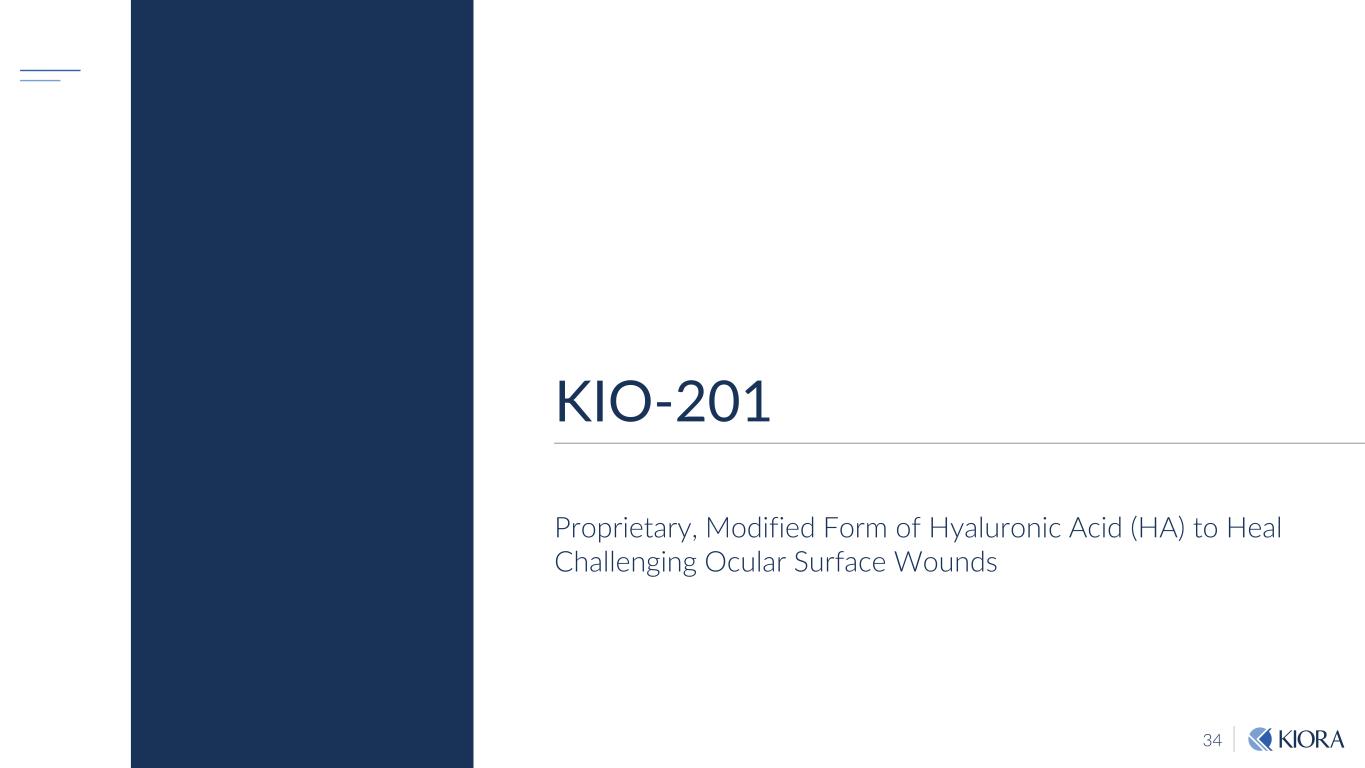
34 KIO-201 Proprietary, Modified Form of Hyaluronic Acid (HA) to Heal Challenging Ocular Surface Wounds
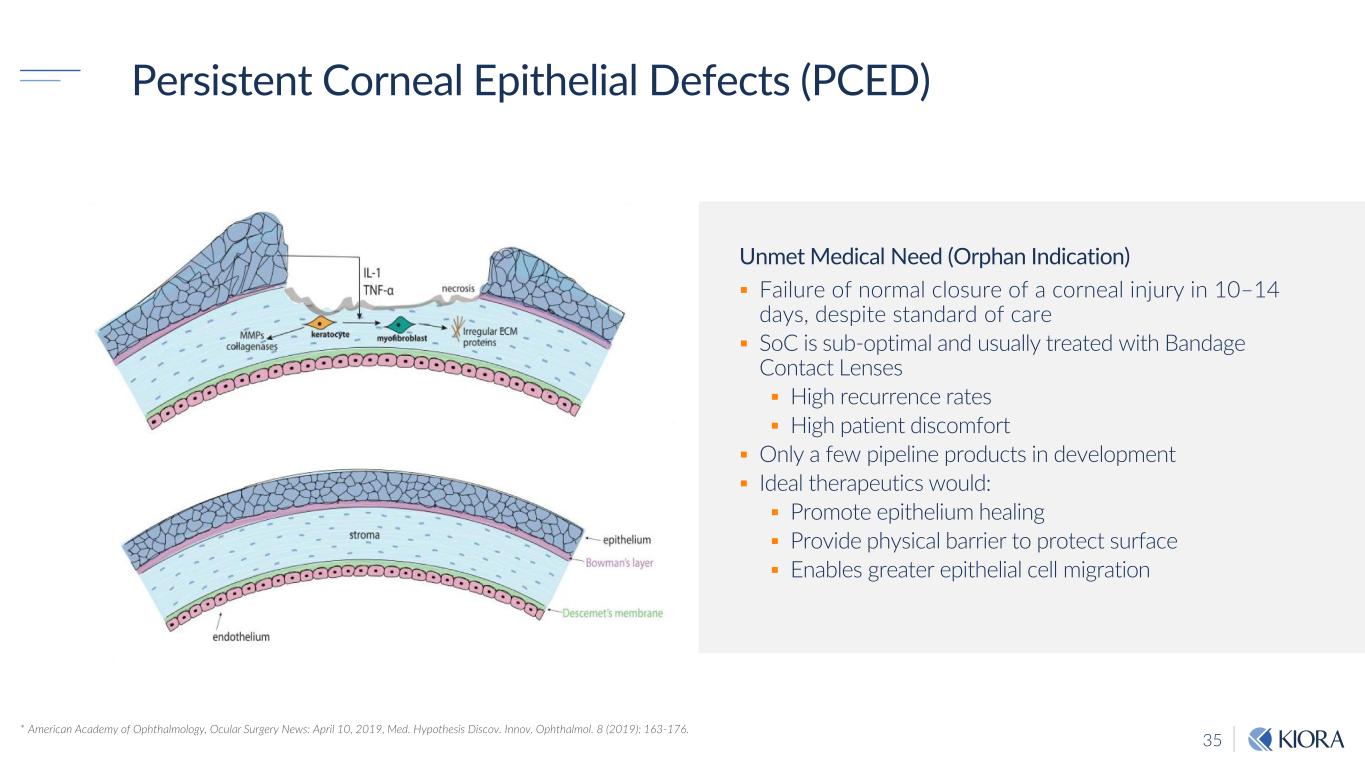
35 Persistent Corneal Epithelial Defects (PCED) * American Academy of Ophthalmology, Ocular Surgery News: April 10, 2019, Med. Hypothesis Discov. Innov. Ophthalmol. 8 (2019): 163-176. Unmet Medical Need (Orphan Indication) ▪ Failure of normal closure of a corneal injury in 10–14 days, despite standard of care ▪ SoC is sub-optimal and usually treated with Bandage Contact Lenses ▪ High recurrence rates ▪ High patient discomfort ▪ Only a few pipeline products in development ▪ Ideal therapeutics would: ▪ Promote epithelium healing ▪ Provide physical barrier to protect surface ▪ Enables greater epithelial cell migration
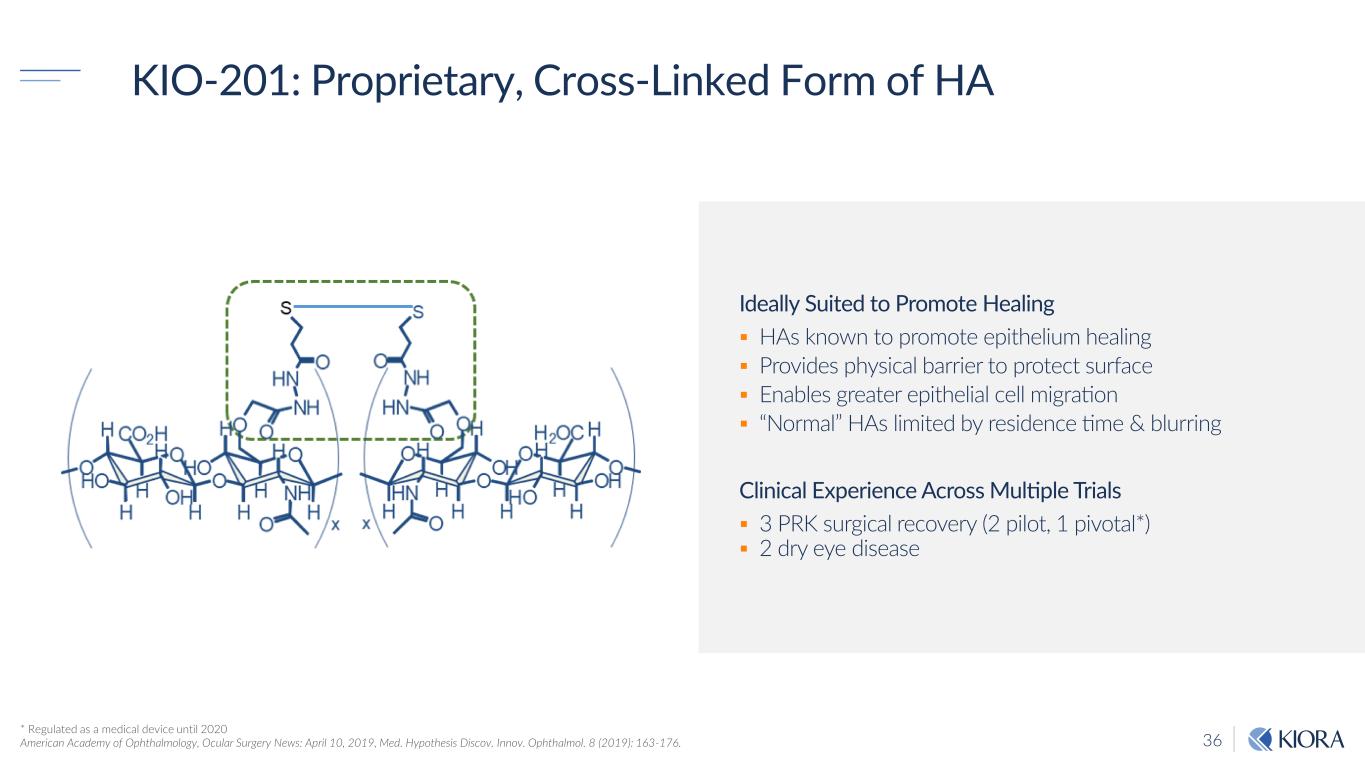
36 KIO-201: Proprietary, Cross-Linked Form of HA * Regulated as a medical device until 2020 American Academy of Ophthalmology, Ocular Surgery News: April 10, 2019, Med. Hypothesis Discov. Innov. Ophthalmol. 8 (2019): 163-176. Ideally Suited to Promote Healing ▪ HAs known to promote epithelium healing ▪ Provides physical barrier to protect surface ▪ Enables greater epithelial cell migration ▪ “Normal” HAs limited by residence time & blurring Clinical Experience Across Multiple Trials ▪ 3 PRK surgical recovery (2 pilot, 1 pivotal*) ▪ 2 dry eye disease
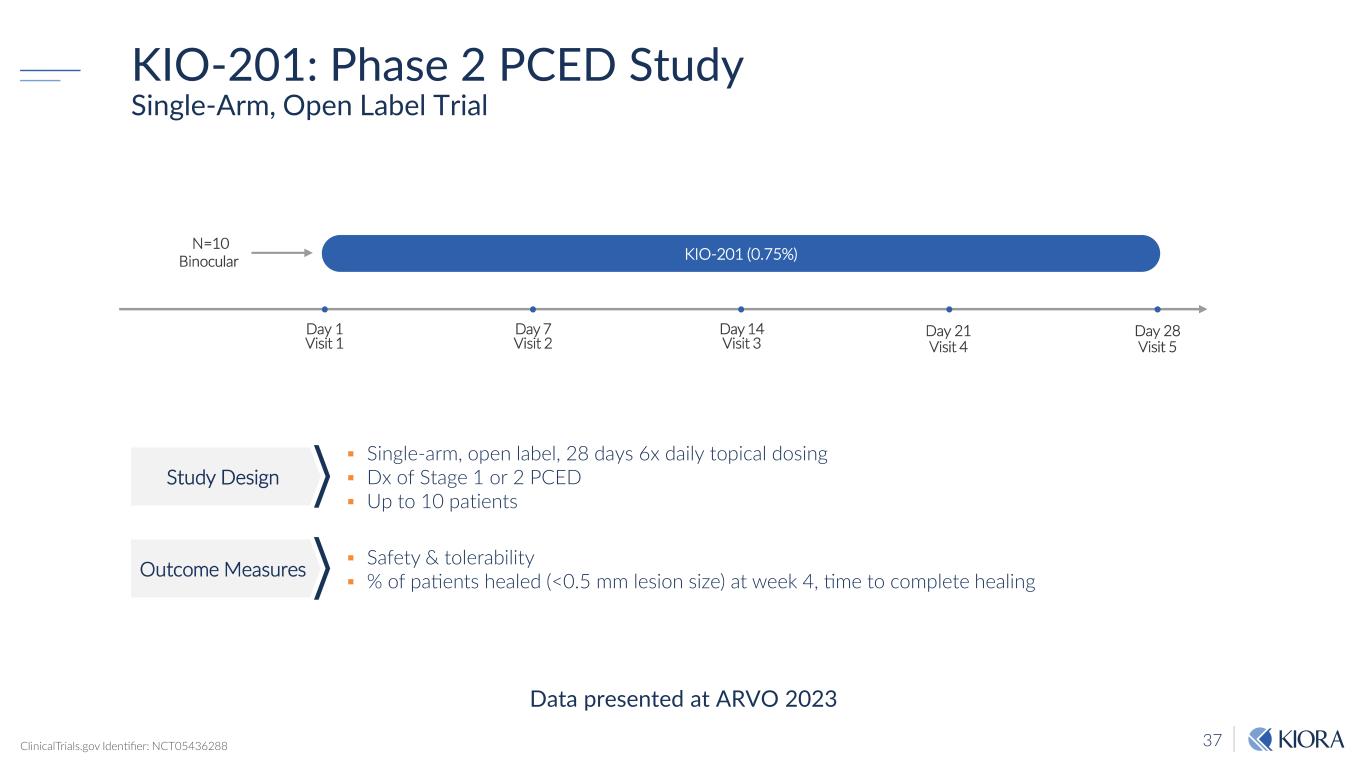
37 KIO-201: Phase 2 PCED Study Single-Arm, Open Label Trial ▪ Single-arm, open label, 28 days 6x daily topical dosing ▪ Dx of Stage 1 or 2 PCED ▪ Up to 10 patients ▪ Safety & tolerability ▪ % of patients healed (<0.5 mm lesion size) at week 4, time to complete healing Day 21 Visit 4 KIO-201 (0.75%) Day 1 Visit 1 Day 7 Visit 2 Day 14 Visit 3 N=10 Binocular Day 28 Visit 5 ClinicalTrials.gov Identifier: NCT05436288 Study Design Outcome Measures Data presented at ARVO 2023
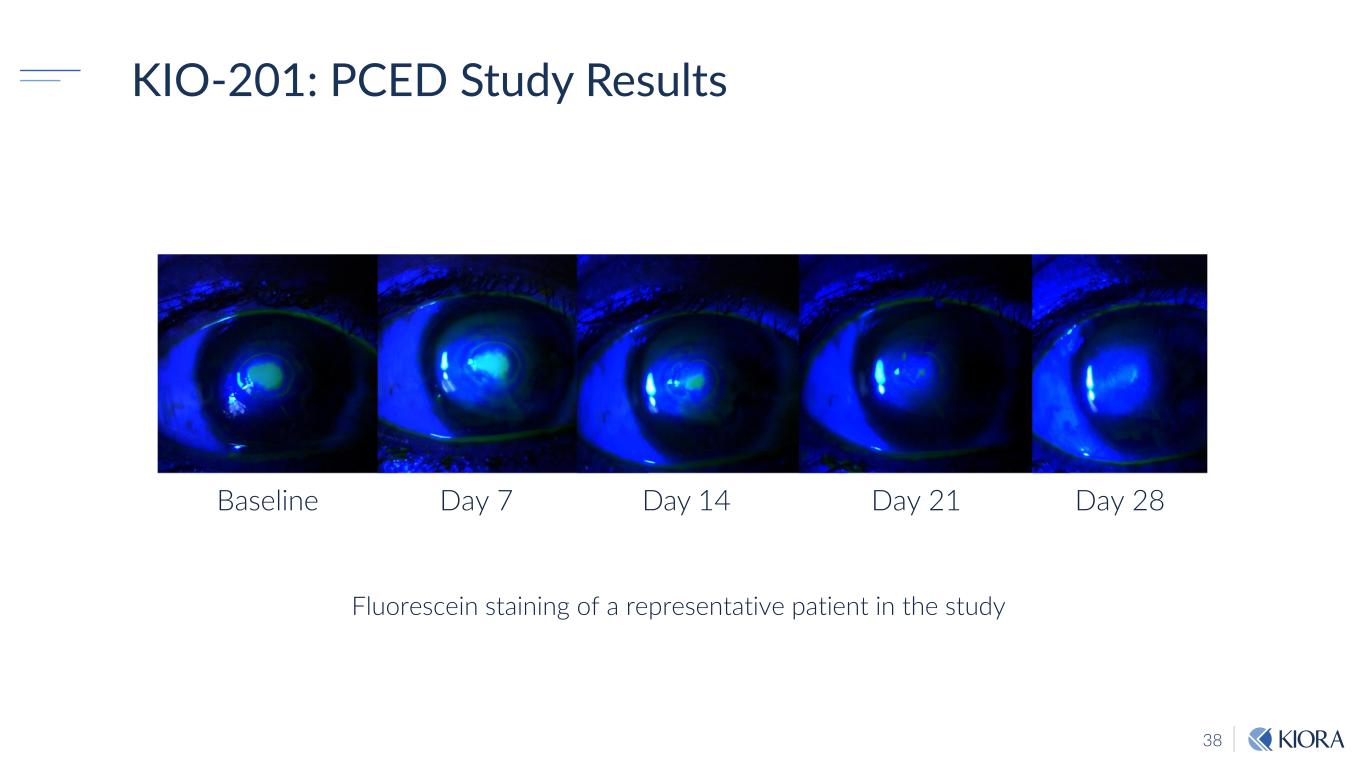
38 KIO-201: PCED Study Results Baseline Day 7 Day 14 Day 21 Day 28 Fluorescein staining of a representative patient in the study
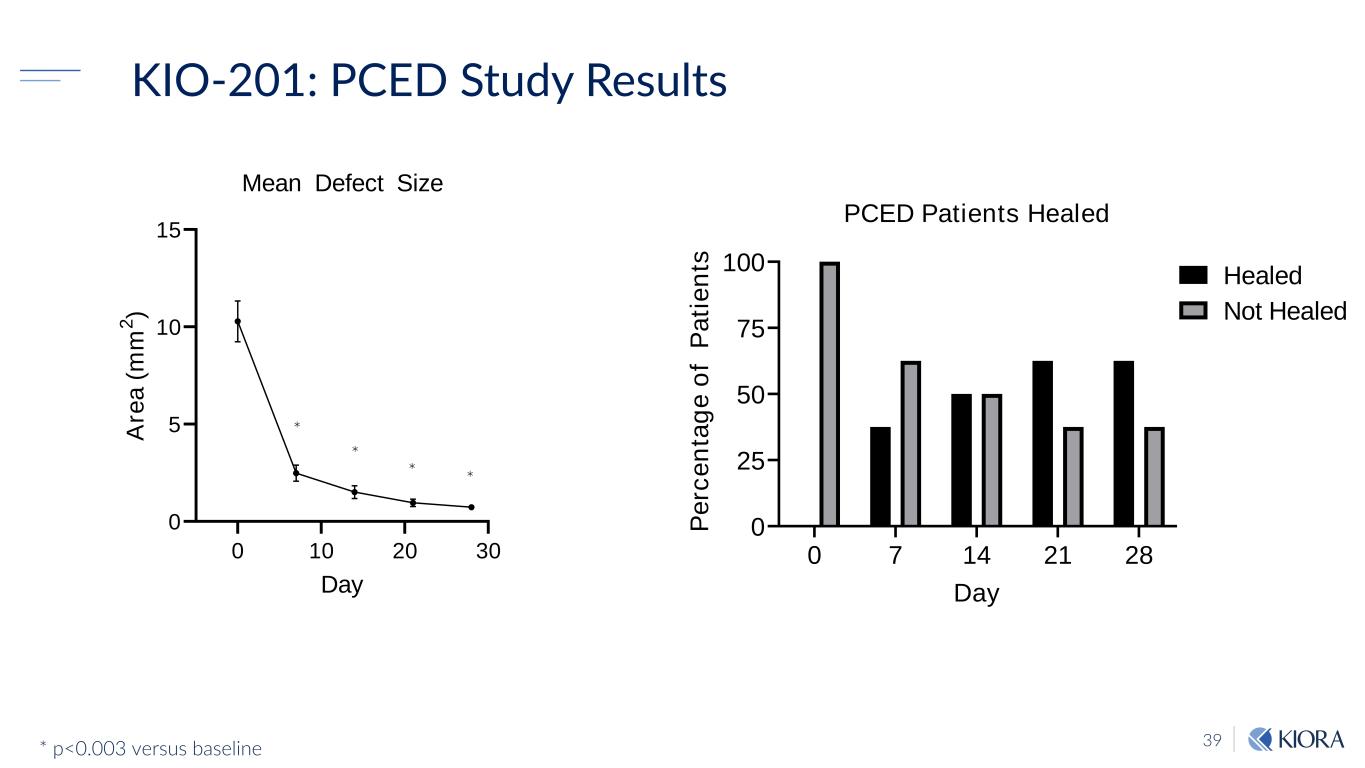
39 KIO-201: PCED Study Results * p<0.003 versus baseline 0 10 20 30 0 5 10 15 Day A re a ( m m 2 ) Mean Defect Size * * * * 0 7 14 21 28 0 25 50 75 100 PCED Patients Healed Day P e rc e n ta g e o f P a ti e n ts Healed Not Healed
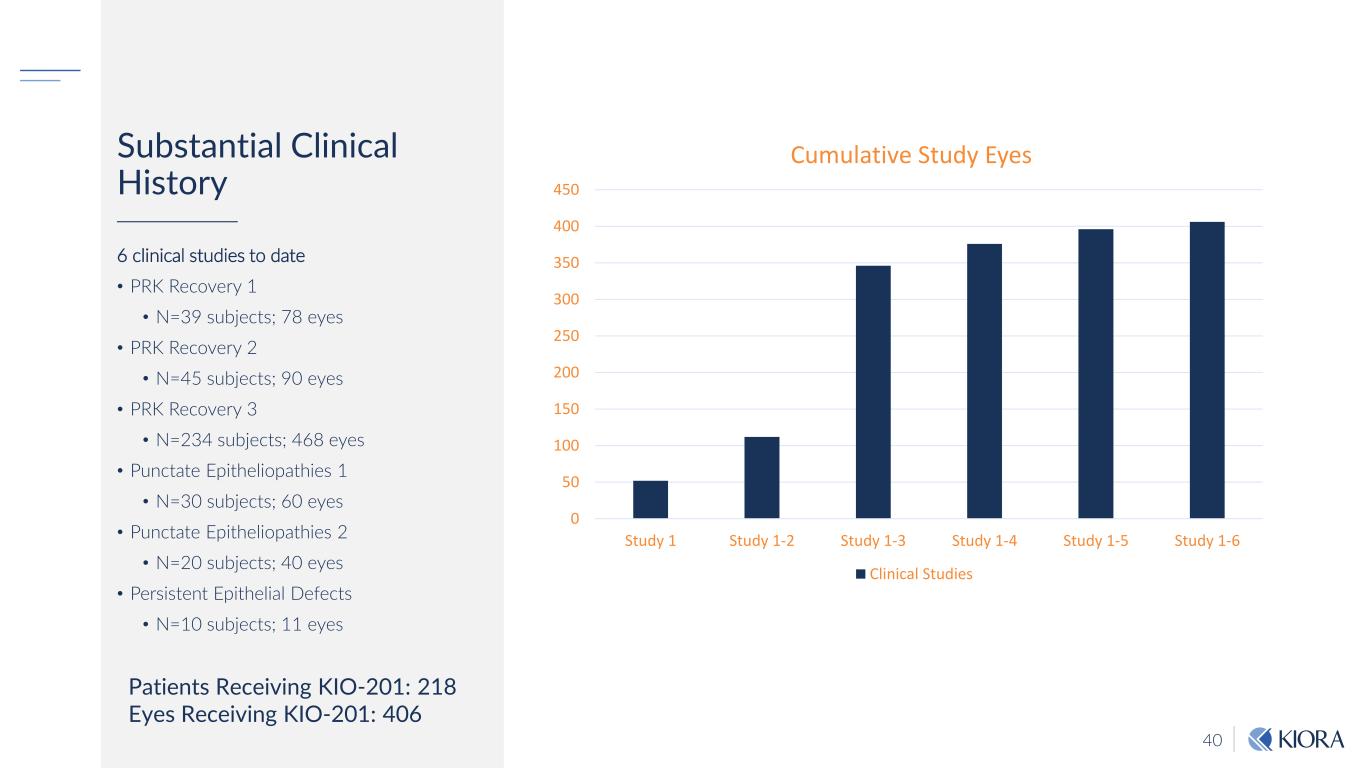
40 Substantial Clinical History 6 clinical studies to date • PRK Recovery 1 • N=39 subjects; 78 eyes • PRK Recovery 2 • N=45 subjects; 90 eyes • PRK Recovery 3 • N=234 subjects; 468 eyes • Punctate Epitheliopathies 1 • N=30 subjects; 60 eyes • Punctate Epitheliopathies 2 • N=20 subjects; 40 eyes • Persistent Epithelial Defects • N=10 subjects; 11 eyes 0 50 100 150 200 250 300 350 400 450 Study 1 Study 1-2 Study 1-3 Study 1-4 Study 1-5 Study 1-6 Cumulative Study Eyes Clinical Studies Patients Receiving KIO-201: 218 Eyes Receiving KIO-201: 406
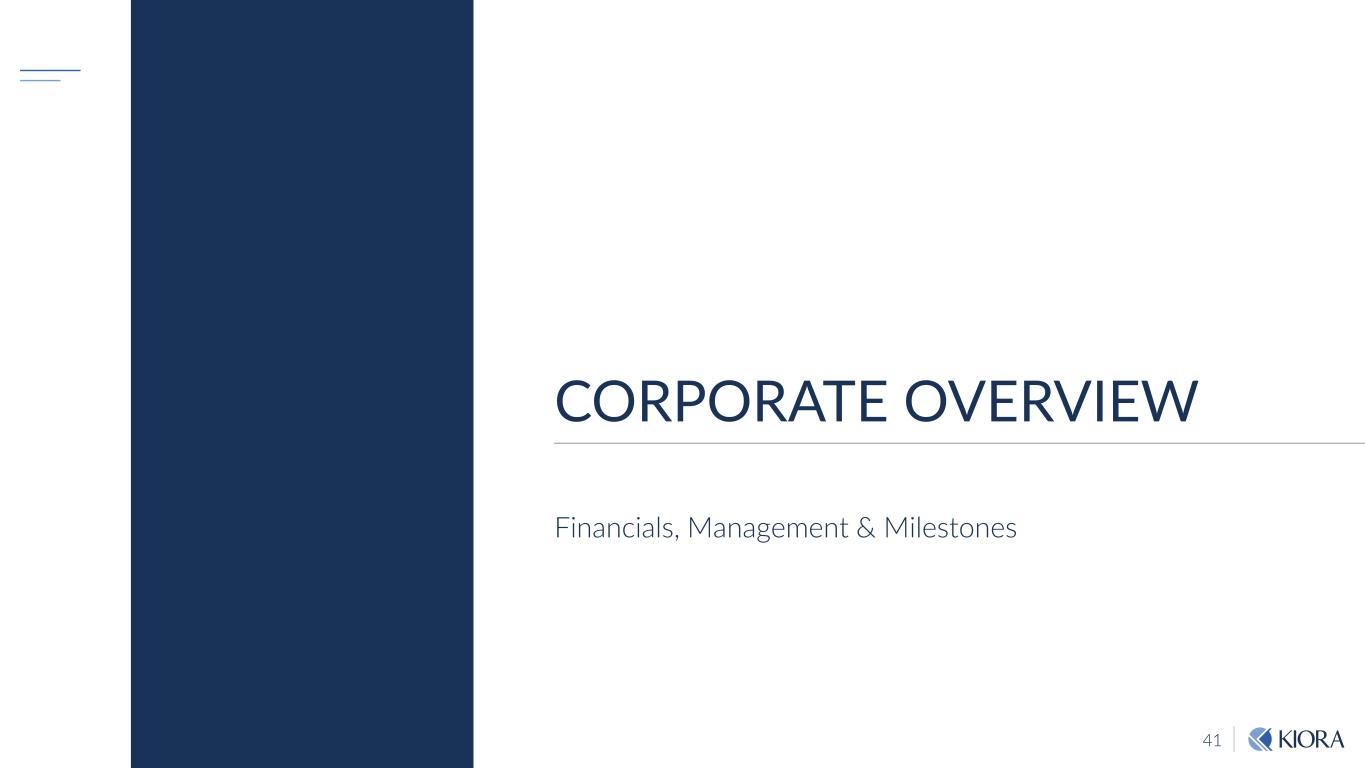
41 CORPORATE OVERVIEW Financials, Management & Milestones
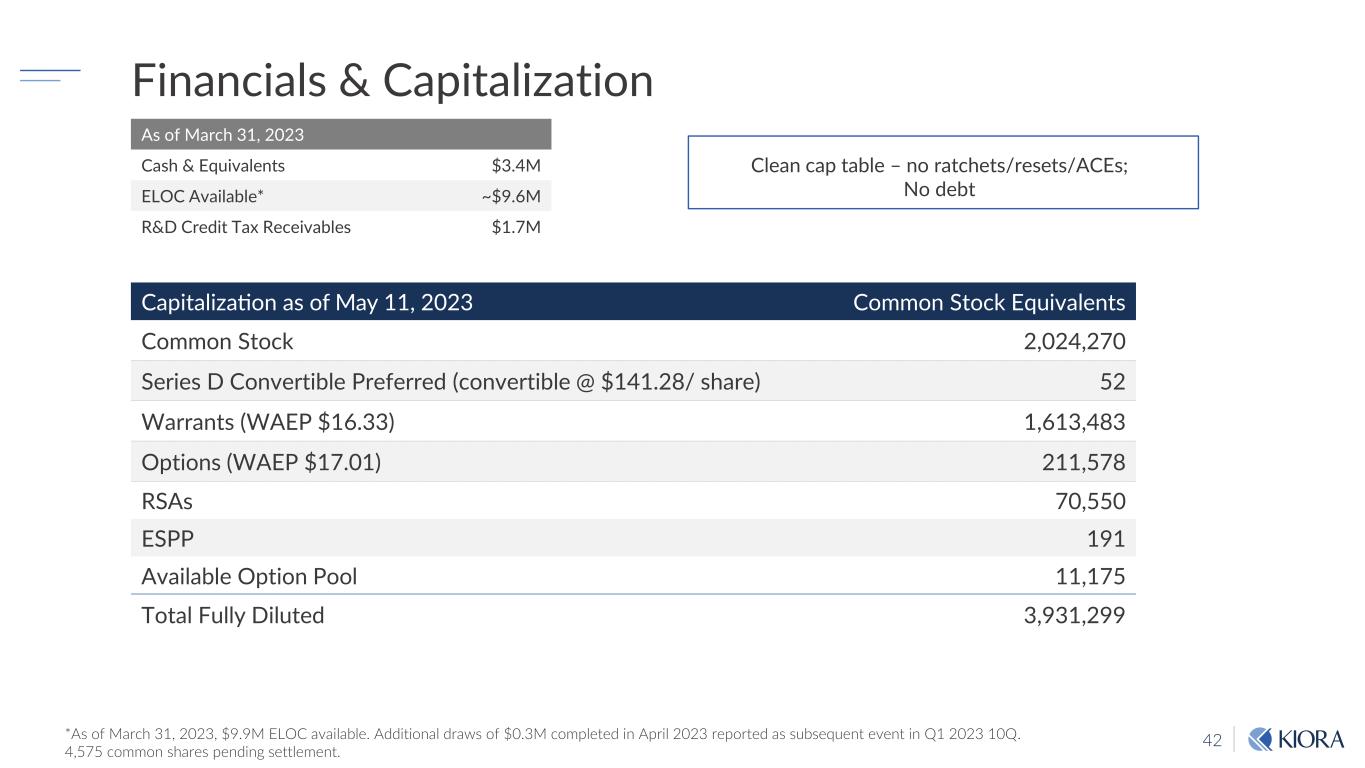
42 Financials & Capitalization Capitalization as of May 11, 2023 Common Stock Equivalents Common Stock 2,024,270 Series D Convertible Preferred (convertible @ $141.28/ share) 52 Warrants (WAEP $16.33) 1,613,483 Options (WAEP $17.01) 211,578 RSAs 70,550 ESPP 191 Available Option Pool 11,175 Total Fully Diluted 3,931,299 As of March 31, 2023 Cash & Equivalents $3.4M ELOC Available* ~$9.6M R&D Credit Tax Receivables $1.7M Clean cap table – no ratchets/resets/ACEs; No debt *As of March 31, 2023, $9.9M ELOC available. Additional draws of $0.3M completed in April 2023 reported as subsequent event in Q1 2023 10Q. 4,575 common shares pending settlement.

43 Capital Raise and Milestones S-1 Follow-On Offering Raising $15M in common stock offering + 50% warrant coverage (5 yr) ~$3M existing + $15M raise $18M Burn Rate ~$850k/mo ~21 mo Operating Capital Capital until March 2025 Q3 ‘23 Q4 ‘23 Q1 ‘24 Q2 ‘24 Q3 ‘24 Q4 ‘24 KIO-301 ABACUS Interim Data KIO-301 ABACUS Full Data KIO-301 ABACUS MAD Initiation KIO-301 ABACUS MAD Interim Data KIO-301 ABACUS MAD Full Data 3+ months operating capital after full data on ABACUS MAD KIO-101 OPRA+ Ph2 Full Data KIO-201 Seek FDA Guidance
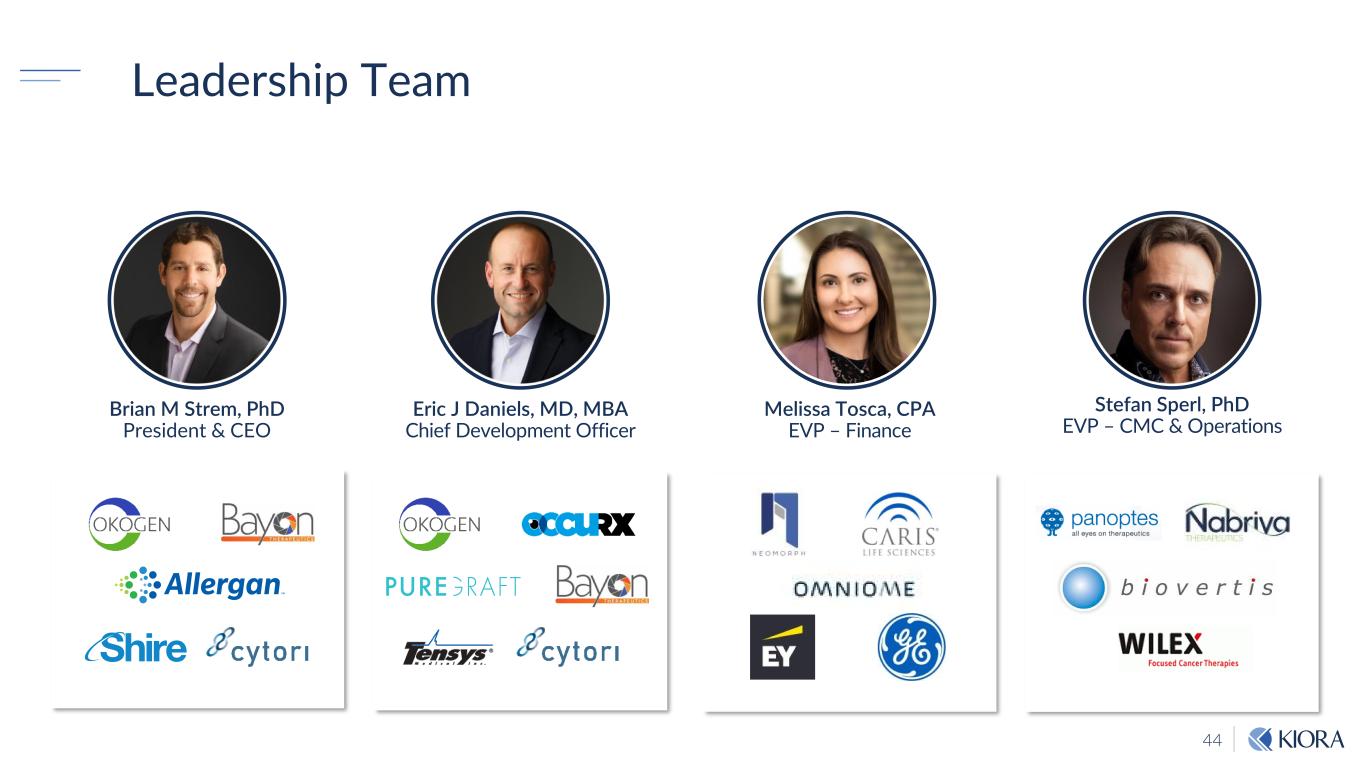
44 Leadership Team Brian M Strem, PhD President & CEO Stefan Sperl, PhD EVP – CMC & Operations Eric J Daniels, MD, MBA Chief Development Officer Melissa Tosca, CPA EVP – Finance
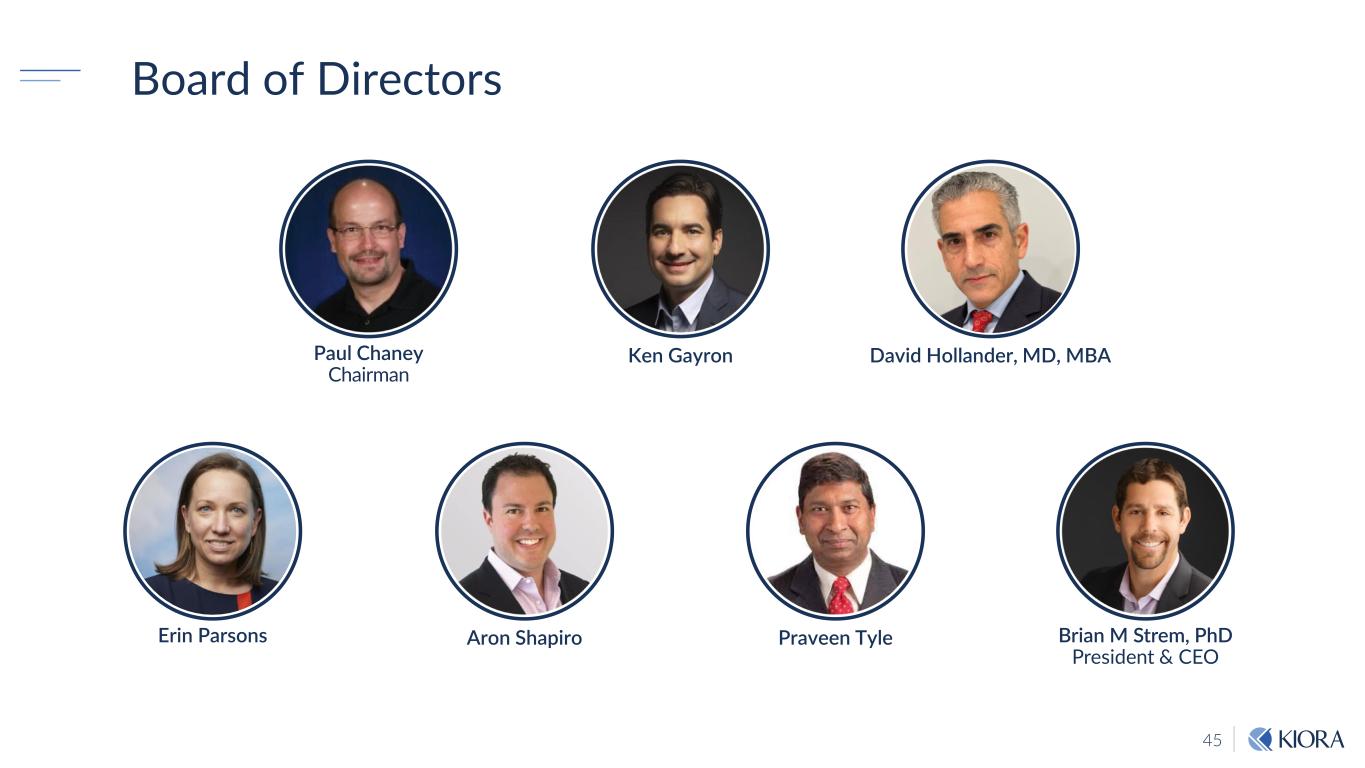
45 Board of Directors Brian M Strem, PhD President & CEO Paul Chaney Chairman Aron Shapiro Ken Gayron Praveen Tyle David Hollander, MD, MBA Erin Parsons
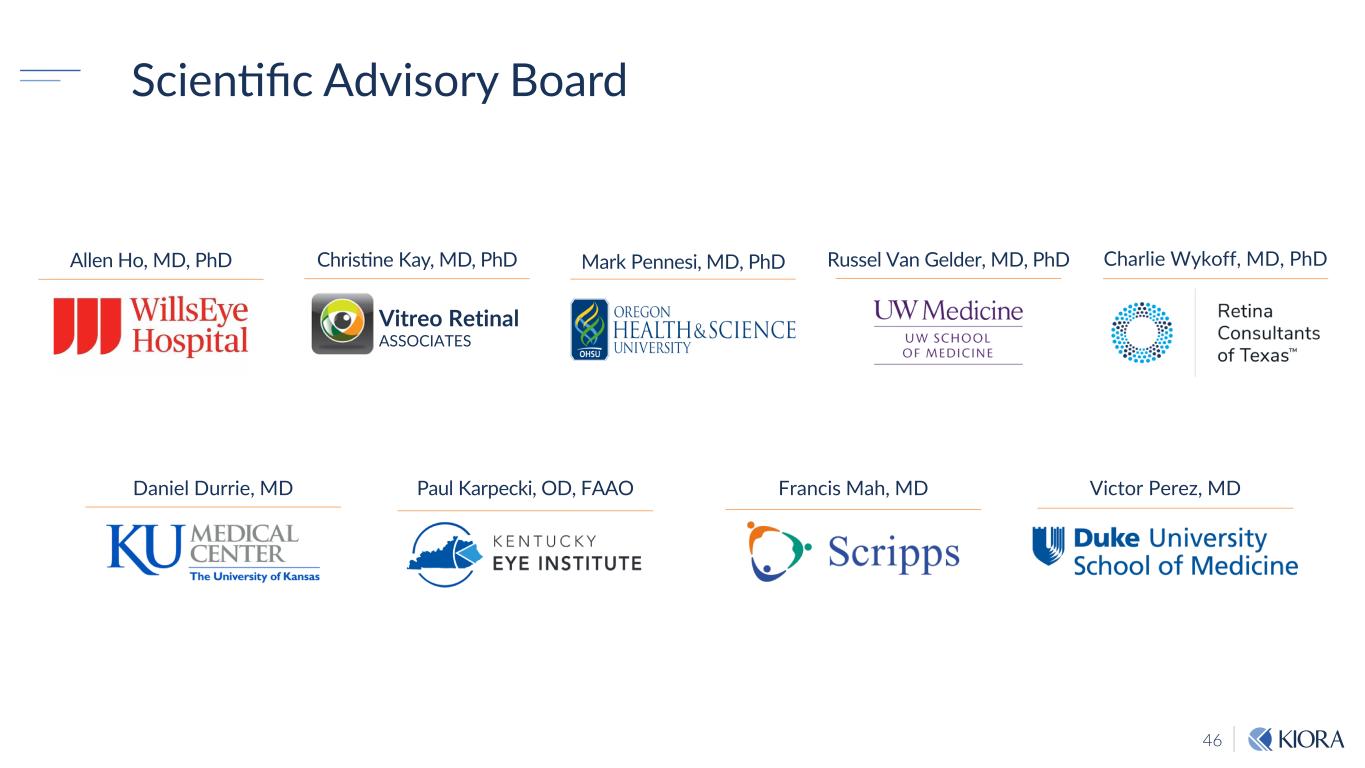
46 Scientific Advisory Board Daniel Durrie, MD Russel Van Gelder, MD, PhD Charlie Wykoff, MD, PhD Victor Perez, MDFrancis Mah, MDPaul Karpecki, OD, FAAO Allen Ho, MD, PhD Christine Kay, MD, PhD Vitreo Retinal ASSOCIATES Mark Pennesi, MD, PhD
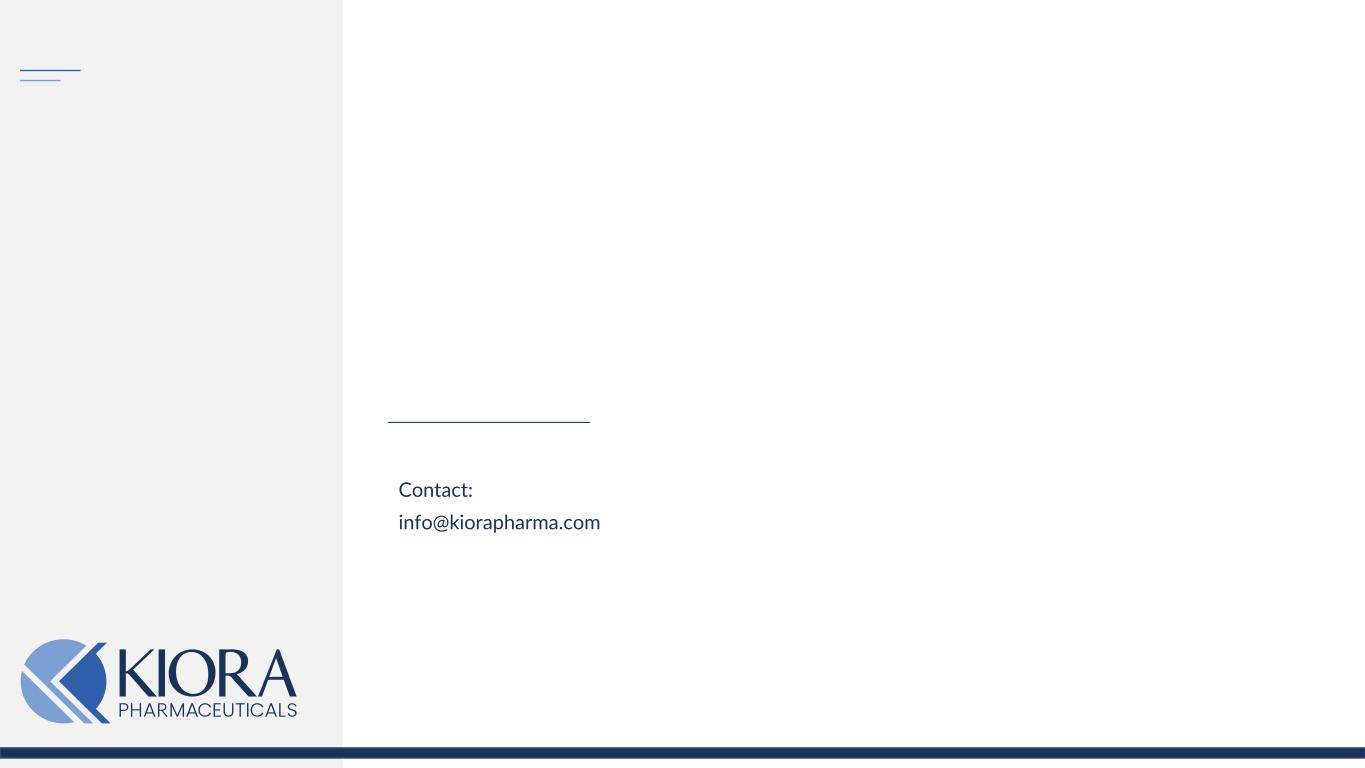
Contact: info@kiorapharma.com